Residential Architects in London specialising in house extensions, property conversions and new build homes.
Don't wanna be here? Send us removal request.
Text
How Much Does It Cost to Build a House? [House Build Cost UK 2021]
When I work on my clients’ projects, one of the main questions I am asked involves the true nature of building costs in London and in the UK.
After delivering more than 700 projects that include extensions, renovations and new build houses and flats in London and the UK, the simplest answer we can give to the question of ‘how much does it cost build a house’ is by assessing your projects’ drawings and bills of quantity (BOQ). Without a doubt, this is the best way to effectively calculate your true building cost but yet even with this method, there are some potential pitfalls when estimating the cost of building a house in the UK.
Having said that, I also believe you can use industry standards that help you estimate the building cost of your home at the preparation stage of your development, especially if you do not yet have your planning permission, building regulations and tender drawings for your project.
Did You Know That Building Costs in London Are the Second Highest in the World and Rising Fast?
House building costs vary widely by location. They differ from one part of the country to another, with central London the most expensive in the UK and the second highest-priced in the world.
As we will discuss, the cost of building a house is influenced by a variety of different factors. This can begin with location and the level of competition for tenders, moving on to building design and specifications. Input costs are key, with labour accounting for around 40-45% of the total cost to build in the UK, this should be taken into consideration.
Today, I will provide you with the early cost advice for your project to help you determine what your project should cost. I will walk you through the industry’s standard/average building cost per square metre in the UK.
I will also explain to you the most important three factors that affect the true cost of building a house, giving you tips to achieve the best value at each and every phase of your project – as well as how to prevent unforeseen expenses.
Want to know more about how much it would cost to build a house in the UK?
Well, you’re about to find out…
1) Building Design
Picture this: you have a budget, you are completely thrilled about your project but do not realise you have been under-quoted on the cost of building a house. All of a sudden, boom! You’ve been hit with having to watch your house building costs increase during construction because they were not planned out correctly.
Yes, I can well imagine the frustration, and after an experience like that you’d naturally want to bang your head against a wall but no fear, I can advise you on this important topic, and how you can prevent this small, but very significant, mistake from happening.
The building design of your home will naturally have a major effect on its actual building cost. Without a doubt, you will need work with an architectural practice that has a reputation of designing projects similar to yours, so that they can help you bring your vision to life according to your taste and requirements, and most importantly, within your budget.
You also need to employ a building contractor who understands the nitty-gritty of target cost certainty for your project. A lot of building contractors sometimes under-quote at the outset of a project, especially for design and build contracts, then they may later ask for extra payment.
You can avoid this happening by appointing independent architects to act as the Principal Designer and Contract Admin for your project, rather than leaving this particular aspect of your project to the building company.
It is crucial that the long-term building design of your project is meticulously developed by your architects from the beginning. This generally involves the aspects of the building that provide structure and insulation, as well as the air-tightness. These are the significant areas of the building that are there for the entire lifespan of the building, and that will also affect the occupiers negatively or positively depending on the decisions made at the beginning of the project.
Your architects should share your project’s planning permission, building regulations and tender drawings with the builders at the tender stage. This is done before work starts so that the prospective builders can understand the design more easily and, more importantly, evaluate costs more accurately. By doing this, the builder you choose won’t be able to change the building cost during the course of construction.
The result? You can sit back, relax and have your mind at ease knowing no extra costs will come knocking on your door.
The specifications that have been well detailed will reduce the risk of you being provided with inadequate materials or workmanship.
How does this benefit you?
It will reduce the risks of disputes about the quality of the work completed, as the standards for a material type or quality alongside its workmanship are stated in black and white.
2) Specifications
Constructing a new space entails hundreds of design and specification choices, and every single option has an effect on the cost of building a house. The more expensive the materials you select, the more money you will spend on your project. The decisions that you make about specific details such as fixtures, finishes, and specifications of your project will not only have an effect on the overall cost, but also on the speed of construction.
Decisions about the choice of materials for your project will be your architect’s responsibility. They need to have an understanding of the applicable parameters for specifying building materials, which can mean a large burden on your finances. Reason being, your project’s specifications are essential to a building’s faultless performance over its lifespan.
You may be thinking, ‘how detailed can this possibly get?’, but a detailed specification will depend on the intricacy and requirements of the job itself. I can recommend basic specifications, by which I mean things such as listing out products and materials by brand and model for complete accuracy and precision. This is an essential part of professionalism in this industry.
Now, think about this for a second.
You give out 100 identical drawings and specifications to 100 builders, and I can assure you, you will get 100 different cost estimates from each builder.
Astonishing, isn’t it?
If your tender documentation is accurate, your final house build cost will generally be within an acceptable range of some +/- 10% of each other. Greater deviations within estimates tend to arise when there is still some ambiguity about the project, meaning that greater deviations arise when your projects specification list is not completed appropriately.
At Urbanist Architecture, we assist our clients in designing their living rooms, bedrooms, kitchens, and bathrooms. By presenting a range of options for finishes, from flooring, wall paints, windows, doors, and lighting to sanitary items, switches and sockets, we provide clients with the ideal balance between the performances, costs, and needs.
3) Project Management
The project management method you choose to build your house will also have a significant effect on your house build cost. Now, you might choose to undertake almost all the project management work yourself, employ subcontractors and thus save the cost of employing a main builder. On the other hand, you might prefer to use a main contractor as the project manager for your project to save time and effort.
Do you see where we’re going with this?
Our experience with developing homes in the UK shows that if the building cost of the project is higher than 100k, the reason for this would be the professional project management by the main contractor and the professional project monitoring by the Principal Designer of the project played an important role in delivering these remarkable results.
Let me guide you on how we do it at Urbanist Architecture.
We provide our clients with a simple, low-risk approach to deliver hands-on project monitoring together with effective and efficient cost engineering. How do we do this?
Simply by using design and build principles alongside techniques for quality control, cost control and ultimately work programme control.
All in all, there are many factors which can affect the building cost estimate and have a significant impact on project cost, and they are as following:
Site investigation, demolition, site clearance, new utilities.
Substructure, foundations, drains, insulation and floor slab.
Superstructure, external walls, internal, walls, roof structure, insulation and air-tightness.
External finishes, roof tiles, doors and windows, and wall cladding and gutters.
Services and fit-out, plumbing, heating, ventilation, electrics, doors, and stairs.
Decorations, plastering, finishes, flooring, tiling and sanitary and lighting.
Patios, paths, driveway, planting and landscaping.
Site management, welfare, health and safety, scaffolding and fencing.
Please be advised that, in addition to the building costs shown in this blog post, there are situations where further costs might arise due to unforeseen conditions on your site. These might include but are not limited to, sloping ground, poor ground or structural conditions and contamination, all of which will be taken into account when progressing with the project.
House Build Cost per Square Metre
Building costs in the UK start from £1,750 per square metre.
The cost of building a house is generally calculated in pounds per square metre of the floor area, so the bigger the floor area, the greater the overall cost.
In 2021, a cost estimation for a house is anywhere between £1,750 and £3,000 per m2.
Along with these costs, you will need to allow an extra 15% of the building cost to cover the costs of hiring your architect, engineer and project managers (or a multidisciplinary architecture practice such as us!), as well as other miscellaneous consultants, needed to execute your project. You will also need to allow an extra 8% of the building cost for statutory consents and contingencies.
How Much Does It Cost to Build a 2 Bedroom House?
The cost of building a 2 bedroom house in the UK is anywhere between £187,625.00 to £281,437.00.
How Much Does It Cost to Build a 3 Bedroom House?
The cost of building a 3 bedroom house in the UK is anywhere between £242,250.00 to £363,375.00.
How Much Does It Cost to Build a 4 Bedroom House?
The cost of building a 4 bedroom house in the UK is anywhere between £294,500.00 to £441,750.00.
How Much Does It Cost to Build a 5 Bedroom House?
The cost of building a 5 bedroom house in the UK is anywhere between £318,250.00 to £477,375.00.
Urbanist Cost Calculator
But hang on a minute… What if there was a way you could get an instant estimate of your renovation, extension or new build project so that you can plan accordingly?
Well, with us you can… We have developed our own tool that makes this whole process super easy for you and it’s absolutely free! It’s the product of us combining our experience and recorded cost data of the works we’ve done previously.
Find out your build cost by using our Urbanist Build Cost Calculator. This tool will calculate your build cost and will give you an overall snapshot of your building cost breakdown.
We are a good fit if…
You prefer a custom, one-size-does-not-fit-all approach.
You are passionate about good design.
You are interested in massively effective projects that are delivered on time and need minimal revisions.
You need an expert, strategic, multidisciplinary chartered architecture firm, and not just the cheapest provider.
You are more interested in receiving an exceptional service than a low-end, perfunctory one.
You want to work with a firm who will fearlessly stand with you as true believers in your proposal’s mission.
[contact-form-7]
The post How Much Does It Cost to Build a House? [House Build Cost UK 2021] appeared first on Urbanist Architecture - London Architects.
source https://urbanistarchitecture.co.uk/cost-to-build-a-house-uk/
0 notes
Text
Double Storey Extensions: Guide to Planning, Design and Build
If you are planning to build a double storey extension, you are not only alone.
There are lots of good reasons why you might want a bigger house: your family is growing, you are working from home a lot more, you need enough room for your hobbies… or you simply want some more space.
If you want more room but don’t want to move, you’ll be considering an extension. And if you want that extension to add a substantial amount of extra space, then what you might need is a double storey extension.
So we’re going to take you through what you need to know about two storey extensions, from the very basics to the planning rules, picking a builder and – because it’s something you’ll be asking from the start – the cost.
Read on…
What is a Double Storey Home Extension?
A double storey home extension, simply put, is where you add an extension to your house and then add an additional floor to that extension. They are sometimes called ‘two storey extensions’.
You may also have an existing single storey extension and wish to build a first-floor extension over the existing one, which would give you a double storey house extension.
A two storey extension is a great way to add another upstairs bedroom to your home and create space downstairs for a larger kitchen, additional bathroom or whatever else you might want or need.
So let’s take a closer look…

Adding a Double Storey Extension to Rear
To begin with, homeowners will often extend their houses to the rear. Many houses in the UK have spacious back gardens and if you’re looking to increase the size of your home, it’s the most obvious land to use.
One advantage is that this won’t change your house’s facade, which will normally please the council. And, as many houses are wider than they are deep, the end result is a more square-shaped building with neat rooms.
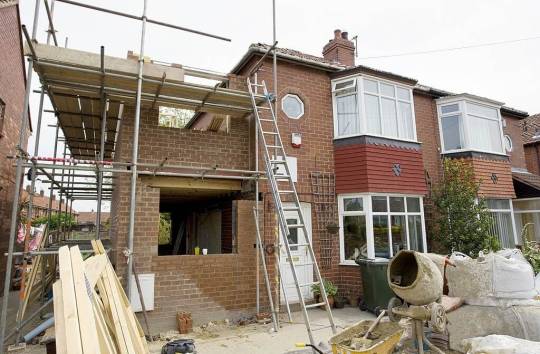
Adding a Double Storey Extension to the Side
If you don’t live in a terraced house, you can then add a double storey extension to the side of your property – either using permitted development rights (if what you want to do qualifies) – or planning permission.
The good news is adding two storey extensions to the side of your house will make your house wider, which will in return enable you to enlarge your kitchen and living area or add additional bedrooms.
Alternatively, if you have enough space on one side of your property, you might even consider building a double storey side extension to create a new dwelling house.
But bear in mind that you will need to have enough parking and garden space for both the new and existing houses, and even then the council might not be in favour of it. When it does work, though, it can be a profitable option.
Therefore, you first need to think about what purpose your double storey extension will serve. You can discuss your plans with your architects to make the most of the space available on the land around your house.
We also recommend you to discuss your plans with your neighbours. This can actually provide an opportunity for them to do similar work, so they may not automatically be against your proposal.
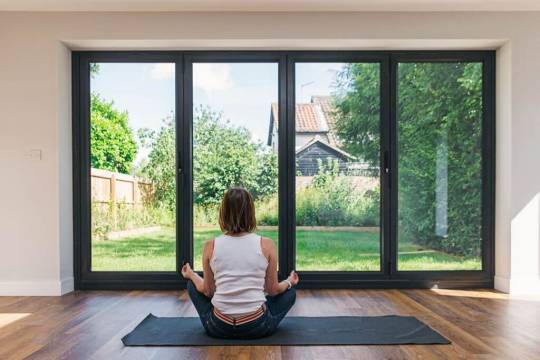
Why are Two Storey House Extensions so Popular?
There are a couple of reasons. Let me explain…
Firstly, it’s cheaper for the amount of additional space. The amount you are going to spend on foundations and the roof will be roughly the same whether you add one storey or two.
Secondly, you’ll get more room. If you’re planning on having a child, they’ll need a bedroom and you can combine this with a downstairs study or an additional bathroom to help counter the needs of a larger family.
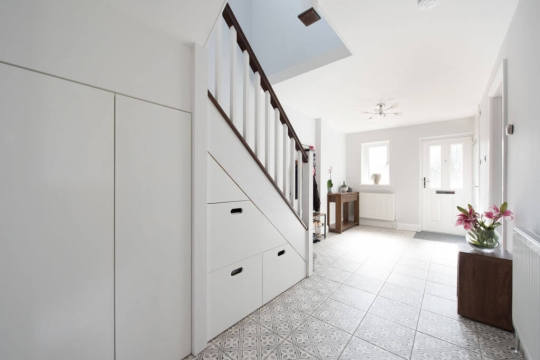
Permitted Development Rights for Two Storey House Extensions
Permitted development rights mean that you can make some changes to your house without applying for planning permission. As a general rule, it makes things faster, cheaper and easier.
Unfortunately, permitted development rights don’t usually apply to most double storey house extensions, but there are some circumstances where they can come into play. For this to happen, your proposed work needs to meet the following criteria:
The double-storey extension should not be wider than half of the original house
The double-storey extension cannot be higher at the eaves than the existing eaves, or the roof of your double-storey extension should not be higher than the roof of the original house
If the double-storey extension comes within two meters of the land boundary then the eaves cannot be taller than three meters
If your house faces directly onto a street, you cannot extend it forwards
The double-storey extension cannot also include any balconies, verandas, raised platforms, microwave antenna, chimneys, or involve any alteration to the existing house’s roof.
The materials used on the outside of the new double-storey extension should match the materials used on the outside of the existing house
Similarly, the roof pitch of the double-storey extension should match the roof pitch of the original house as closely as possible.
The land used for the double-storey extension should not be within seven meters of any land boundary or extend beyond the rear wall of the original building by more than three meters
If you’re building a side elevation and want to put a window on the first floor, it should be obscure-glazed and non-opening unless the openable part is higher than 1.7 meters from the floor
Here’s the most important part: You will not qualify for permitted development if you want to build a double storey extension to the side of your home, or if you live in certain protected areas (eg, a conservation area, an area of outstanding natural beauty or a national park).
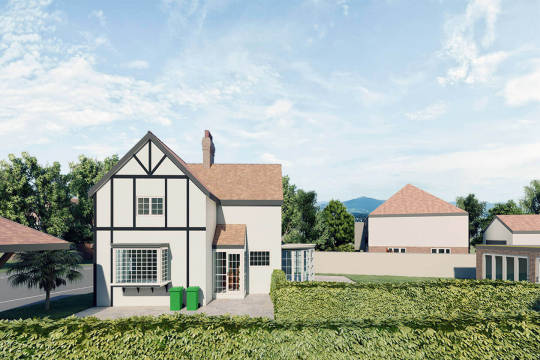
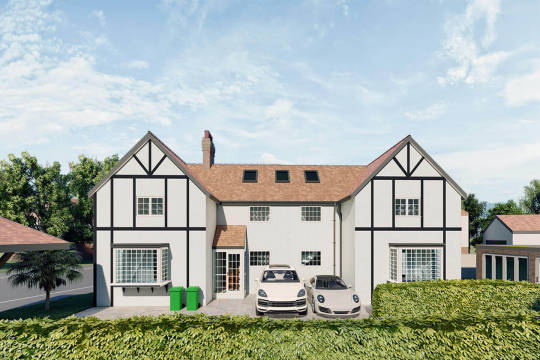
Planning Permission to Build a Two Storey Extension
If your double storey extension does not meet the rules for permitted development rights, then you will have to apply for householder planning permission to build your two storey extension.
What does that mean?
It means it will take longer for you to reach the point when you can start building. It also means that you’ll have to think about whether the council will like the look of your extension. And planning officers will check to see if it is in the spirit of a range of local policies.
In short, your architects and planning consultants will develop your design, prepare your planning drawings and Design & Access statement to justify why you should receive planning permission for two storey extension. If you want to know more about the planning application process, have a look here.
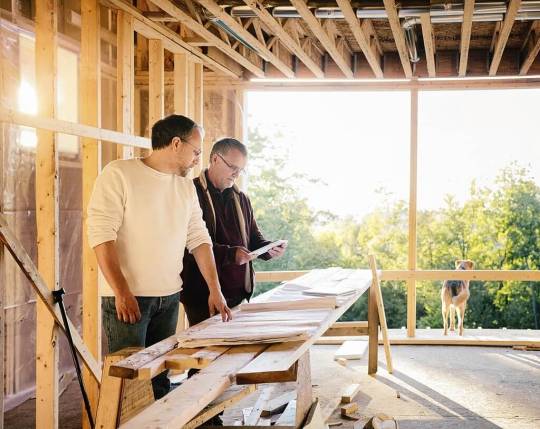
Do I Need Building Regulations Approval to Build a Double Storey Extension?
Regardless of the size of your two storey extension, you will need to apply for Building Regulations Approval. You will require a full set of building regulations drawings, structural calculations and specifications to submit your building control application.
One of the scariest things for anyone looking to extend their home is the thought that everything could, quite literally, come tumbling down. This is more likely to happen if you don’t have proper foundations, and they’ll need to be deeper and wider for a double storey extension.
But first a warning: You should also get temporary propping systems to keep everything secure and in place whilst the extension is finished.
When you’re working with your architect, you’ll need to discuss the structural design and the structural integrity of the extension. You’ll also need a structural engineer to help you calculate everything, and their work should be accompanied with the Building Control application you will make for your double storey extension.
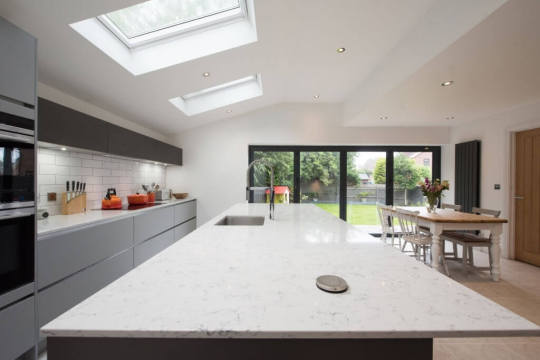
Two Storey House Extension Ideas: How to Design Yours?
You might need a little bit of help with this!
Luckily, there are very creative extension architects who can help you and work with you to build something that you’ll love, and take into consideration all of your ideas and requirements.
So let’s take a closer look at design ideas for double storey house extensions…
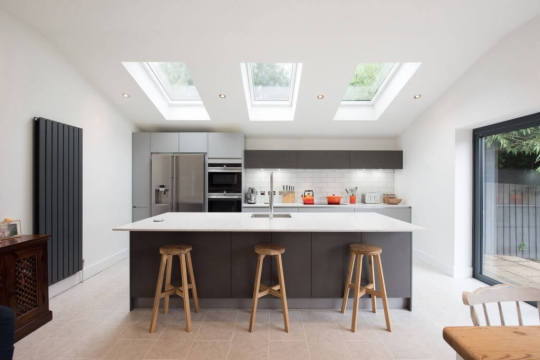
Internal Layout Ideas for Downstairs
To begin with, what you choose to do with your new downstairs space really depends on your needs.
For example, if you are planning on working from home, it could make a good home office. Or if you are planning to upgrade your kitchen, you can do so and create a spacious open-plan living-dining area.
Imagine for a moment how you can transform your downstairs to add more space, comfort and value!
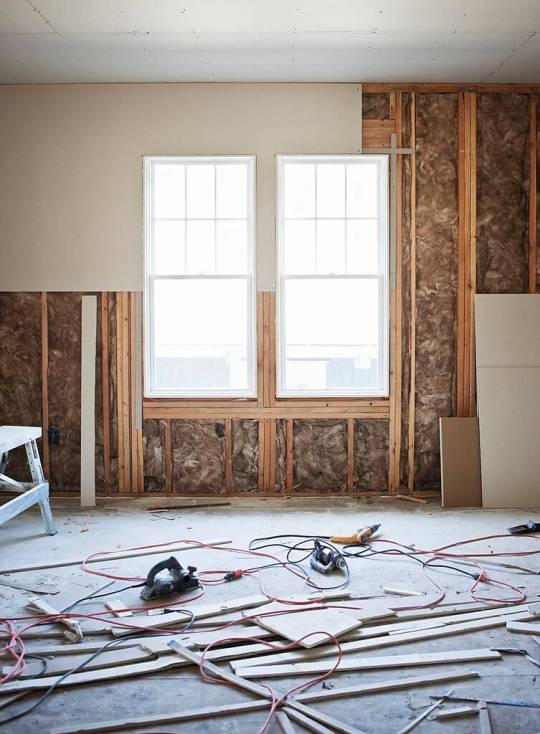
Internal Layout Ideas for Upstairs
In general, most people go for a bedroom in the upper half of their new extension. However, there’s no rule that says you have to do that.
Here’s another way to think about it: You could use it for a second bathroom; a playroom or nursery if you have or are planning to have children; an office or study or even a little library.
In fact, you might even want the new space to connect to an existing room either in the form of an en-suite bathroom for the master bedroom or to just to give you more space in an existing bedroom, bathroom or playroom.
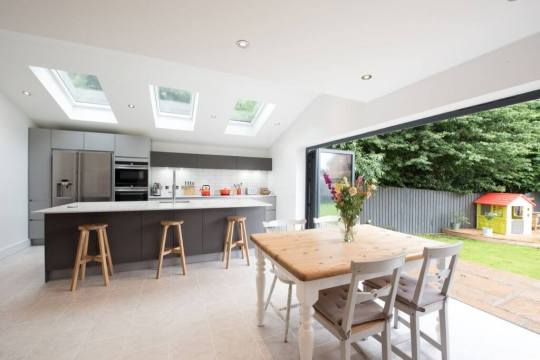
Bi-folding vs Sliding Doors for Double Storey Extensions
One of the wonderful things about double storey extensions is that you can tailor them to your needs and desires. That’s why finding the right right doors is so important.
That is why, one of the many things you’ll get to choose when you’re planning your double storey extension is what sort of doors you prefer: bi-folding doors or sliding doors.
Now consider it this way: Bifolding doors are more unusual and require you to keep the area around the door clear on both sides so you can open them fully.
On the other hand, sliding doors are glass panels that roll along wheels at the top and the bottom so you can open the space between rooms or into the garden cleanly and easily.
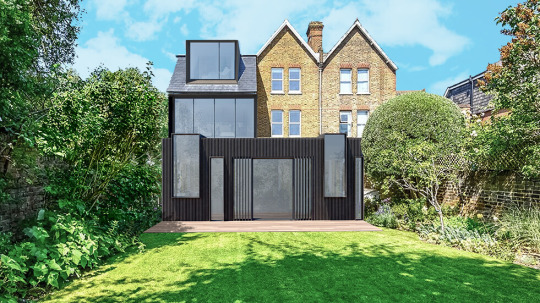
Exterior Materials for the Extension
One of the fun things about a double storey extension is that you don’t have to make it match with the rest of your house. Yes, you read that right!
Some homeowners use the same materials, and it does look great, but you can also try new materials for the contrast and look into new, environmentally friendly options or affordable metal cladding options, that might suit your needs even better.
For example, you may consider using bamboo for the outer walls and topping your extension with a green roof.
Alternatively, you can use reclaimed timber or brick, which will both help the planet and give your extension a bit of character. With reclaimed timber, you’ll also avoid one of the drawbacks of using wood on the exterior, which is the uncertainty about how it will age and the fear that what looks great when newly built will look shabby within a few years.
Or, you may consider using metal cladding such as steel cladding, aluminium cladding, zinc cladding or copper cladding to achieve a suberb look and great durability for a stunning two storey extension.
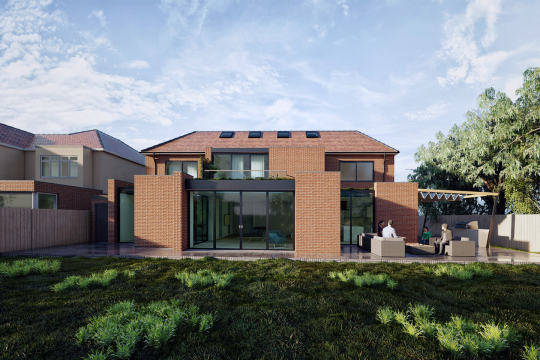
Adding a Two Storey Extension to a Detached House
The simple truth is, it is usually easiest to add a large two storey extension to a detached house. It won’t disturb the neighbours as much, and you can choose between a rear double storey extension or a side double storey extension.
Quite simply, your options for doing something large and complicated – if that’s what you are thinking of – are much greater. With a detached house, there’s more chance that you will get exactly what you want right now – with other property types, you would need to make more compromises.
Even so, it can pay off not to be too set in your ideas – your architect might be able to design a beautiful double storey house extension for your detached house that can save you money or give you something that works much better with the rest of the house than your initial plans.
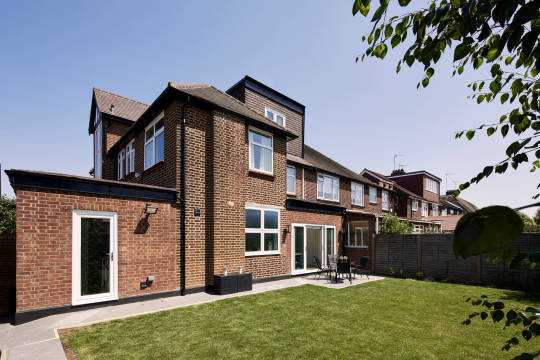
Adding a Two Storey Extension to a Semi-Detached House
There are still plenty of choices for adding a two storey extension to a semi-detached house. You can have a double storey rear extension or a double storey side extension on the part of your house that is not attached.
Needless to say, it will be more intrusive for your neighbours than if you had a detached house, so you should pay close attention to any loss of light or overshadowing you might be causing the next-door house.
If you are thinking of a side extension, you need to consider whether the council will mind that you are disturbing the symmetry of the pair of semi-detached houses. Before you commit to the idea, have a walk up and down the length of your street to see if there are many similar examples. Then check if they were approved planning permission in recent years.
Of course, your neighbours might have already extended out to the side, in which case you would only be matching them. The potential issue there is the council worrying that a group of semi-detached houses are turning into a terrace. For all those reasons, a double storey side extension can sometimes be a harder sell to the council than a rear one, although we still frequently secure planning permission for difficult house extensions.
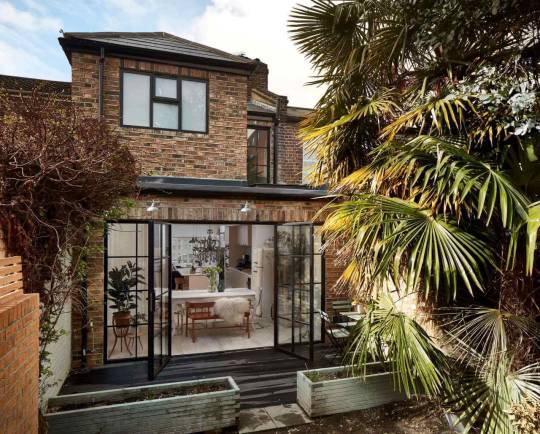
Adding a Two Storey Extension to a Terraced House
This is the most difficult, but don’t let that put you off: most architects love the challenge!
There won’t be an option to put a double storey extension on either side of the house, so you can only build a two storey rear extension.
Because terraced house owners are a lot physically closer to their neighbours, there can be significant issues with things like making sure that light doesn’t get blocked from other people’s homes and gardens.
Here’s the clue: With a good architect, the disadvantages can be used as the starting point for a distinctive design, maybe with slanting walls or even curved ones. Because you can’t add a simple box, you’ll end up with a creative house extension – something much more special and much more yours.

Adding a Double Storey Extension to a Listed Building
If you want to add a double storey extension to a listed building you will need to apply for Listed Building Consent first.
Let me say this straight: As a Listed Building owner, you will also need to look at the original design of your house, research the materials and techniques used and then see if you can replicate them so that the house doesn’t look mismatched. It’s not impossible to do, but it will involve more effort.
A word of caution: Always work with experienced listed building architects, planning consultants and contractors to preserve your listed building’s historical assets, including its structure.
For an in-depth exploration of how to go about extending a listed building, head here.
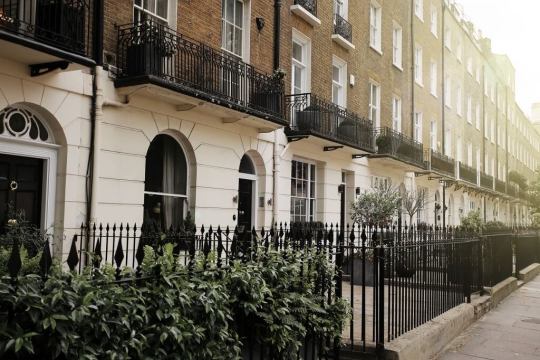
Adding a Double Extension in a Conservation Area
Just as permitted development is never an option for extending a listed building, you’ll always need to get planning permission before adding a double storey extension in a conservation area.
Conservation areas were introduced during the 1960s to protect and preserve the character of a local area due to its unique architectural or historical character that needs to be preserved under Section 69 of The 1990 Planning (Listed Buildings and Conservation Areas) Act.
The positive thing about a conservation area is that the rules should – in theory – be much clearer. That’s particularly true if you were thinking about a double storey side extension, which would have to stick closely to the conservation area appearance if your house as it is right now has been judged to be making a positive contribution to the local character. You will have more freedom with a two storey rear extension that can’t be seen from the street but your choices will still be more restricted than elsewhere.
Before you hire an architect, make sure that they have good experience of working in conservation areas and understand the particular nature of the one your house is in.

How Do You Find and Choose the Right Extension Architect?
First of all, start by having a think about what you’d like. If you own the house with your partner, discuss it with them.
Do a little bit of research and try to be clear on what you’re looking for and what you want to avoid. Get an approximate budget and understand how this might affect your choices and options.
Take a look for an architect online. If you visit the Royal Institute of British Architects’ website, you can use the ‘Find an Architect’ tool to start searching. If you live in a smaller community, talk to friends, family and neighbours to see if they have any recommendations or ideas.
When you’ve found a talented extension architect, make sure that they’re aware of all the necessary planning restrictions and building regulations that are applicable in your area. If you live in a listed building, or a conservation area, make sure that they have experience with this and ask to see some examples of their work.
You might want to try and find a multidisciplinary practice, a firm of architects and planning consultants and interior designers who can handle all of the planning, design and construction and any unexpected challenges. They may also be able to help you find a builder and inspect the construction of your two storey home extension.
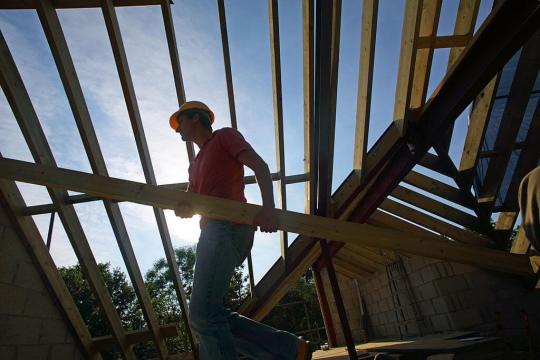
How Do You Find and Choose a Good Reliable Builder for Building a Two Storey Extension?
Getting a good and reliable builder is absolutely essential, no matter what work you’re doing. You don’t want to have to deal with someone who you don’t trust, or to build a double storey extension that falls apart after a few months.
So, what do you do?
Start by having a conversation with your architect. They should have worked with builders on previous projects and should be able to give you a unique insight into what to look for and which extension builders are the best.
If you would rather look independently, start by drawing up your criteria and looking at our ‘hiring a builder’ checklist. This will help you avoid any cowboy builders and show you which questions to ask and what you need to look up before hiring anyone.
For instance, you should ask and see if they’ve worked on double storey extensions so you know that they’ve got relevant experience, and ask to see photographs of their previous work.
You should also have a Building Contract in place before the commencement of works. If they won’t commit or refuse to sign a contract, be extremely cautious about agreeing to let them do your double storey extension.
Regardless of how you find your builder, make sure that they’re someone you can trust and respect: you’re about to give them a lot of money and access to your home, so you need to feel safe.
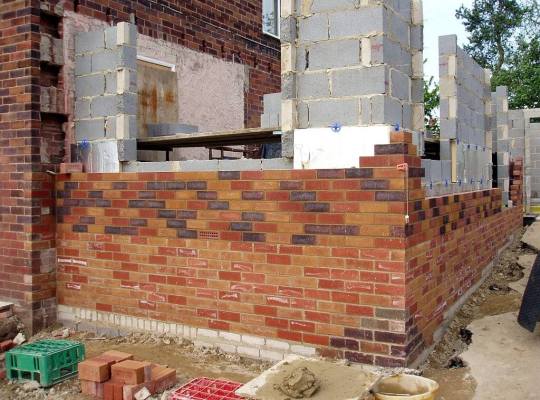
What Is The Cost of a Two Storey Extension?
It’s difficult to say precisely, as it depends on many key parameters such as the type of the foundation required, likely construction methods, corresponding structural approaches and desired levels of fixtures, fittings and material finishes.
However, we can give you a range, and for a double storey extension in London, it’s likely to cost between £1,750 and £2,750 per square metre. But don’t immediately be put off: think of this as an investment. Two storey extensions often increase the value of your house, sometimes by up to £4,000 – £6,000 per square meter.
As well as the costs for builders and materials, you should also budget for a planning application fee, building control fee, architects’ fees (which usually cost between 8-12% of the build cost), structural engineers’ fees and party wall surveyors fees.
In any case, some of the things that will affect the cost of your design are the types of material that you choose, how complicated the design is, what sort of fixtures and fittings you want and how many structural changes you’re planning on making to the existing building.
But one thing’s for sure: You’ll also need to consider where your house is: as a general rule, houses in London and South East England are much more expensive at a base price, but things may be more affordable in the North. Just remember that, often, the more you spend on making your home nice, the more money you’ll eventually be able to sell it for.
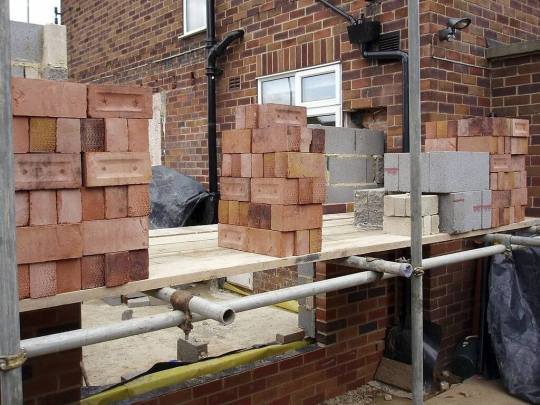
How Long Does It Take to Build a Double Storey Extension?
The short answer: Generally about 9 to 11 months from the very first steps to being able to cook in your new kitchen or sleep in your new bedroom. But it’s probably more useful to break down the process into three stages.
Here’s how that works:
Developed Design + Planning: 3 months
Technical Design + Building Regulations: 2 months
Contract Administration + Construction: 5 months
However, whenever you embark on a project that involves construction, you need to be prepared for unexpected delays. So please view these timings as an indication of what usually happens, rather than something you should be making firm commitments by.
For peace of mind, it’s probably best if you prepare yourself for a completion date that’s over a year from when you begin.

How Urbanist Architecture Can Help?
Urbanist Architecture is a London-based RIBA chartered architecture and planning practice with offices in Greenwich and Belgravia. With a dedicated focus in proven design and planning strategies, and expertise in residential extensions, conversions and new build homes, we help homeowners to create somewhere they enjoy living in and landowners and developers achieve ROI-focused results.
If you would like us to help you with your double storey extension – or any other kind of house extension, please don’t hesitate to get in touch.
We are a good fit if…
You prefer a custom, one-size-does-not-fit-all approach.
You are passionate about good design.
You are interested in massively effective projects that are delivered on time and need minimal revisions.
You need an expert, strategic, multidisciplinary chartered architecture firm, and not just the cheapest provider.
You are more interested in receiving an exceptional service than a low-end, perfunctory one.
You want to work with a firm who will fearlessly stand with you as true believers in your proposal’s mission.
[contact-form-7]
The post Double Storey Extensions: Guide to Planning, Design and Build appeared first on Urbanist Architecture - London Architects.
source https://urbanistarchitecture.co.uk/double-storey-extension/
0 notes
Text
How to Convert Offices into Homes without Planning Permission [December 2020 update]
December 2020 note: This post has been fully updated. In addition, we now have related posts on the new permitted development right to demolish offices and replace them with flats and the new use classes. Please contact us if you have any questions about how the new regulations could affect anything you are planning.
It shouldn’t come as a surprise that there is still great demand for housing in London and the UK. An increasingly common solution is to get a change of use from office (B1 under the old system) to residential (C3) to make the most of a subdued market for office and retail space and turn it into housing, and this phenomenon is happening up and down the country.
That was the case even before the long-term effects on working patterns from the COVID-19 crisis. Now, with demand for offices likely to decline, property owners will be looking for new uses for their buildings. With the new use classes, they will have more flexibility in converting them to commercial purposes, but we still think that office to residential is going to remain the most appealing option.
Read our handy guide below and use our proven formula to make a successful prior approval application for your office to residential conversion.
Can I Covert Offices to Residential Units without Planning Permission?
Yes, you can! And you may not need to apply for planning permission for change of use from B1 to C3.
Here’s how:
Permitted development rights (PDR) is a government scheme that allows certain types of change of use to be carried out without applying for planning permission. One of them is from B1 to C3, making the planning process simpler and more straightforward. However, there are certain aspects that still have to be taken into considerations and not every office or retail space can be converted into housing.
This is largely because, in the wrong hands, PDR has been used by unscrupulous developers to create micro flats that impact negatively on built environments and communities. The Levitt Bernstein report called for the government to end PDRs for B1 to C3, with particular reference to ‘Crowding and Space’ hazards due to lack of sufficient space, light and ventilation evident in poor quality housing.
The government is determined to keep this PDR. It has, however, responded to the criticism by making two crucial changes. In July 2020, it added natural light for all habitable rooms in housing built or converted under permitted development. Even then, the initial rules for the new set of PDRs didn’t specify space standards. Finally, though, in September 2020, the government announced that the Nationally Described Space Standard would cover all new homes, whether they were created under planning permission or permitted development.
We welcome these belated changes. However, we think the legacy of the first wave of low-quality conversions will be a cloud over the sector for some time to come. Therefore, for your good reputation (and the long-term profits that protects) we strongly recommend using our expertise to employ the most ethical approach to develop high-quality homes that are beneficial for all concerned.
How Do I Make a Prior Approval Application to Change Use from B1 to C3?
Before you commence carrying out the works for converting your office units into residential units, you need to make a prior approval application. Your application should include full set of drawings and supporting documents relating to the transport and highway impacts, contamination risks, flood risks and noise.
If your property complies with the prior approval mechanism, your council cannot apply any other planning policies in determining the prior approval application. All you will need to do is to use a proven formulate to convert offices into homes.
We are sure that you will work with successful architects and planning consultants so you can make the most of this opportunity! Your planning consultant can help you design your development, prepare your drawings and submit and manage your prior approval application.
Once we submit your prior approval application to the council, they then have 56 days to make a decision. Once you get approval, you’ll be ready to start work on your conversion development and maximise your investment!
What Are the Important Points I Need to Consider?
We agree with the Royal Town Planning Institute that poor use of PDRs generally delivers low-quality, unprepossessing housing in awkward locations. We encourage developers to get involved and ensure their projects provide high-quality accommodation that meets existing permitted development guidelines in terms of space standards and integration into the existing urban fabric.
As Julia Park, former chair of the RIBA Housing Group and one of the authors of Levitt Bernstein’s report, stated in a guest blog post for Shelter, ‘proposals just need to be subject to the normal, democratic, planning process. Good conversions will be approved and bad ones will be rejected.’
It’s worth noting too that office-to-residential developments aren’t well-suited to town and city centres. We’ve seen similar projects create blank façades that strip high streets of their vitality and exacerbate existing problems. This is the rationale behind councils in London issuing Article 4 Directions.
What are Article 4 Directions?
Article 4 Directions happen at a local level and reserve the council’s right to reject PDR and prior approval applications, particularly in places with a designated purpose – for example conservation areas, tech clusters or employment centres.
This means that you’ll definitely need to apply for planning permission to convert your offices into houses or flats in those instances and it’s essential to check with your architectural team and council if Article 4 applies to your site before launching your project.
B1 Is Being Abolished – Does That Change Anything?
You may have heard that the B1 office use class is being abolished, with offices joining the huge new E class with everything from shops to gyms. So does that mean that the office to residential permitted development right is disappearing? Or possibly that it’s extended to all class E buildings? No, and, for now, no. For the transition period – which lasts until 31 July 2021 – existing permitted development rights stay in place. After that? The government is consulting on a new permitted development right for the whole of Class E to be converted to residential – but that’s not available yet. If and when it comes in, we will replace this blog post with one covering the new situation in detail.
Urbanist Architecture Team, RIBA Chartered Residential Architects
How Urbanist Architecture Can Help You Convert Office Space into Residential Units
All the above factors must be taken in consideration and our expertise will make your prior approval process simpler, easier and quicker.
As architects and planning consultants with extensive experience in conversion of offices into flats, we’ll help achieve the maximum number of units. We will help you with the preparation of full set of drawings and supporting documents relating to the transport and highway impacts, contamination risks, flood risks and noise of your development, and manage your prior approval application throughout the process.
Get in touch with us today to see how you can join hundreds of developers who’ve successfully achieved these conversion projects. We’ll guide you every step of the way through your office to residential change of use journey.
Get in touch today.
We are a good fit if…
You prefer a custom, one-size-does-not-fit-all approach.
You are passionate about good design.
You are interested in massively effective projects that are delivered on time and need minimal revisions.
You need an expert, strategic, multidisciplinary chartered architecture firm, and not just the cheapest provider.
You are more interested in receiving an exceptional service than a low-end, perfunctory one.
You want to work with a firm who will fearlessly stand with you as true believers in your proposal’s mission.
[contact-form-7]
The post How to Convert Offices into Homes without Planning Permission [December 2020 update] appeared first on Urbanist Architecture - London Architects.
source https://urbanistarchitecture.co.uk/how-to-convert-offices-into-homes-without-planning-permission/
0 notes
Text
Paragraph 79 Houses: Building a New Home in the Countryside
Have you ever found yourself dreaming about building a Paragraph 79 house?
Building your own grand design house in the countryside is a dream for lots of people; something to aspire to and daydream about. But could it turn out to be a reality?
Well, for any of these daydreams to transpire into bricks and mortar you’ll need to be fully up to speed with Paragraph 79 (or ‘Para 79’) of the National Planning Policy Framework, previously known as Paragraph 55 (or ‘Para 55’).
This article will show you exactly how to design Paragraph 79 houses so that you can build a unique and individual bespoke house, tailored to match your needs and aspirations.
You will learn how to work collaboratively with your architects and planning consultants to increase your chances of getting planning permission for your Paragraph 79 house in the countryside or on the Green Belt.
We will show you outstanding design examples, explain the principles of good design and reveal the importance of innovative construction and sustainability methods. And if you don’t own a piece of land yet, we will also show you a step-by-step guide to help you find the best plot for developing your countryside house.
So let’s begin…
What is a Paragraph 79 Country House?
Paragraph 79 projects follow the guidelines in criterion (e) of Paragraph 79 of the National Planning Policy Framework (NPPF) (formerly paragraph 55 of the National Planning Policy Framework), which governs the construction of new, isolated homes in the countryside.
To begin with, paragraph 79 of the National Planning Policy Framework (NPPF) is a unique piece of legislation that provides exceptional circumstances for allowing the construction of isolated dwellings within the countryside. The policy assesses a planning application against a set of tests to ensure an exceptional quality design that reflects the highest standards in architecture.
In fact, paragraph 79 began life back in 1997 as Planning Policy Guidance 7 (PPG7) and was introduced by then Environment Secretary John Gummer (now Lord Deben). In its earliest form, the guidance stated that:
“An isolated new house in the countryside may also exceptionally be justified if it is clearly of the highest quality, is truly outstanding in terms of its architecture and landscape design, and would significantly enhance its immediate setting and wider surroundings’. This means that each generation would have the opportunity to add to the tradition of the Country House which has done so much to enhance the English countryside”.
As years and governments have passed, PPG7 slowly transformed into Paragraph 79, but the initial framework remains. The current legislation states that a house given Paragraph 79 planning permission must:
be of exceptional quality;
be truly outstanding or innovative;
reflect the highest standards in architecture;
help to raise standards of design more generally in rural areas;
significantly enhance its immediate setting;
be sensitive to the defining characteristics of the local area.
We will explain each of these imperatives in detail below but let’s have a look at how to obtain planning permission for a house in the countryside first.
How to Get Planning Permission for Paragraph 79 Homes
Paragraph 79 is an exception in the planning system that allows the construction of new houses in the countryside. You will be required to justify that your proposal meets the stringent requirements set out in Paragraph 79 in order to gain approval for an exceptional dwelling within an isolated setting.
Needless to say, when preparing your planning application, you need to pay special consideration to sustainability in terms of the location of the site, the proposed building design and construction technologies; visual impact on the countryside; and landscape design. Therefore, you need to adopt a meticulous design-led approach if getting planning permission for Para 79 house is your end goal.
Like getting planning permission in the green belt, gaining approval for an exceptional dwelling within an isolated setting can be difficult – each application brings its own unique set of challenges.
Unfortunately, there is no formula for providing a ready answer to any planning permission question for Paragraph 79 homes. Neither is there any rigorous and objective approach to assess Paragraph 79 planning applications for the criteria set out above.
The simple truth is each application has its own unique set of circumstances, which will be independently assessed by the local planning authority or the Planning Inspectorate. With the right team of professionals working on your project, you can pull out all of the stops to justify why your proposal should be granted consent.
And once completed, your Para 79 dwelling will become part of a legacy for future generations to enjoy and gain inspiration from. Remarkably, people will benefit from the innovative, outstanding design of your property through a trickle-down effect.
The truly unique design elements of your Para 79 house will set the standard for design for years to come. Meaning this policy presents the opportunity to inspire and influence housing design of the future. Imagine what it would be like!
So now you have a basic understanding of the fundamentals of the Paragraph 79 policy, let’s look at its imperatives in more detail and learn how to design an outstanding building to improve the chances of getting planning permission in the countryside.
Paragraph 79 Policy Explained in Detail
Paragraph 79 of the National Planning Policy Framework (NPPF) provides exceptional circumstances for permitting the construction of isolated dwellings within the countryside. The policy assesses a planning application against a set of tests to ensure the proposal meets these specific criteria of Paragraph 79.
Be of Exceptional Quality
Your planning application will be subject to rigorous analysis, but it may be of benefit to highlight your considerations about the exceptional quality of design, starting with the building.
It sounds simple. But it isn’t.
In fact, it can be extremely difficult to pin down what is meant by exceptional quality design as exceptional quality will mean different things in different locations and settings. It will be dependent on the existing design standard and the key characteristics of that area.
However, despite there not being a clear definition of exceptional design, what is clear is that your proposal must be way above the ordinary. Not only must your proposal be unique, but you must also look to push the contemporary boundaries of construction and design methods.
Believe it or not, the depth of understanding of Paragraph 79 will vary from council to council; therefore you should do everything in your power to ensure that your local planning authority has a strong core understanding of the policy and know how to apply it.
Let me say this straight: Exceptional quality of design also requires the balance and integration of building design and landscape design – the marriage of structure and its topography. That is why it is crucial that you give equal consideration to the landscape design and the design of the building itself.
In other words, this isn’t just a landscape afterthought; this is landscape design front and centre to give you the best chances of winning planning permission.
Therefore, your architects should collaborate with a successful landscape architect as a part of the design team from day one as new isolated homes in the open countryside require the creation of a distinctive sense of place that fully integrates the building with its topography and surroundings. Make no mistake about it!
With attention to detail towards high design quality of the building and its harmony within its landscape settings, you can achieve an exceptional quality development that draws on its distinctive setting, whilst remaining contemporary, modern and timely.
While the merits of exceptional design are open to subjective interpretation, there are a number of steps you can take to ensure that you have done everything in your power to achieve exceptional results. For example, early engagement and correspondence with your local planning authority and a Design Review Panel will increase your chances of your application being successful. But more about that later…
Be Truly Outstanding or Innovative
It is important to note that the policy requires your design to be truly outstanding or innovative; not necessarily both. Previous versions of this policy, such as that outlined in the PPS7 (Sustainable Development in Rural Areas), required the proposal to be innovative and outstanding.
While your scheme doesn’t need to be both, it is recommended to aspire to both to make every attempt to increase your chances of approval.
Here’s another way to think about it…
Paragraph 79 is the premier league of housebuilding and design – the policy wants dwellings to be at the forefront of ground-breaking design and construction and to raise the standard of design in general.
By and large, the policy tries to reinvent traditions into something more avant-garde and contemporary, creating an opportunity for each generation to create their own legacy through outstanding architecture. This means that your outstanding design should be bold and daring, and look to celebrate the distinctiveness of the local area.
Perhaps unsurprisingly, innovation is something that dovetails with modern schemes; modernity is often assumed to be “innovative” but this doesn’t mean that traditional schemes can’t be innovative too.
In fact, innovation can be reflected in a home’s design and engineering, and it is an area that is trending big style in Para 79 schemes. The difficulty with innovation in architecture is that it demands a constant raising of the bar.
Remember: Your scheme should be a unique one-off design; repetition is not an option. Being truly innovative means doing something completely different opposed to doing the same thing but better.
Beyond that, proving architectural innovation is not just a tough task – it is ultimately self-defeating; the risk being the creation of a generation of prototype houses that exist in their own little world, rather than raising the standard of available housing stock.
The truth is innovation in architecture demands that the wheel be constantly reinvented; it is out of the question to propose something that has already been done and claim it is innovative. The aim is to create your very own landmark structure. There is no doubt that the balance is heavily in favour of contemporary interpretations of the country house, but with a sustainable flavour, however, this does not mean that traditional schemes cannot be adopted.
But one thing’s for sure: There is not a “one size fits all approach” to innovative design. What would be considered innovative in one setting may not be considered in another; it can be very situational. It is a pointless exercise getting inspiration from previously approved schemes, because what has been considered innovative in one proposal simply will not be deemed innovative in another.
What it all boils down to is that a clear innovative concept that has evidently driven the design of the dwelling can provide sufficient evidence to support your application. Innovative concepts can include low carbon homes, off-grid hydrogen homes and designs that incorporate green technology. Linking architecture, landscape design and mechanical and engineering often results in truly outstanding and innovative design quality.
What’s more, Sustainability has become a golden ticket to get projects through pre-application, outline planning application and full planning application as a route to claim innovation. The sustainability agenda has become implicit since Para 79 was introduced and is a key part of the National Planning Policy Framework (NPPF). Using a sustainability consultant is commonplace, but the desire to get approved sometimes means that sustainability for its own sake overshadows a genuine design need for it.
Despite the policy itself only being short, you require a substantial amount of evidence support a Para 79 scheme. Gathering sufficient evidence to convince the local planning authority that a design is truly innovative has its challenges. Similar to exceptional quality design, what is classed as innovative is open to subjective interpretation. So it’s time to start thinking outside of the box.
Reflect the Highest Standards in Architecture
To gain approval in the countryside, designing a beautiful home is not enough. Your home must be an expression of progressive and pioneering design fit for the 21st Century and beyond.
Therefore, a Para 79 house with the highest principles of architecture should incorporate sustainability into the building envelope by adopting heat recovery ventilation, triple-glazing, insulation, rainwater harvesting and passive solar gain etc.
Collectively these sustainability principles can be referred to as Passivhaus principles. Passivhaus design is a standard for design and construction that aims to create homes that maintain comfortable temperatures with minimal energy use.
The fact is that Passivhaus principles are merely sensible design and something any planning officer would expect to see in a Para 79 project. However, these are not, on their own, reasons why they would automatically grant planning consent. While Passivhaus principles were innovative in the field of sustainable design when they were first introduced, they can now be considered extremely common.
Obviously, a combination of factors will help you to justify whether your scheme helps to reflect the highest standards in architecture. If your proposal meets the other five criteria set out within the policy, then it should be well on its way to reflecting the highest standards in architecture. This following quote from a planning inspector in an appeal decision reinforces this point:
“The building would be constructed to a high level of energy efficiency incorporating many sustainable construction features including high standards of thermal insulation, rainwater harvesting, air source heating, photovoltaic panels and low energy lighting. I consider that this dwelling is of a very high standard of architecture, includes a number of innovative features, and would raise the standards of design more generally in rural areas.” (Appeal Ref: APP/N2535/W/16/3149772 – approved at appeal)
Help to Raise Standards of Design in Rural Areas
Despite a general drive to increase the quality of design of new build homes, the reality is that the vast majority of houses in the countryside consist of mass-produced housing stock. What this means is that the large majority of new build homes are less than remarkable, cookie-cutter builds with below-par environmental performance.
Therefore, the Paragraph 79 of NPPF has been introduced which seeks to promote “exceptional quality” homes with “outstanding” design quality in open countryside, on designated Green Belt land and for Areas of Outstanding Natural Beauty (AONB). Paragraph 79 policy encourages developments that demonstrate quality efforts that match and compliment the environment they reside in.
In other words, policy also acknowledges the issues of typical housing design and is important in architects’ professional development. It makes them respond to a setting and produce amazing outcomes. A Paragraph 79 home should aspire to be noticed on a national stage for its use of experimental design and technologies.
In order to help raise standards of design in rural areas, your proposal must become an exemplar for outstanding and innovative rural architecture, from which future projects can take inspiration from. You can achieve this through the use of particular materials, the adoption of particular methods of construction or through conservation of the environment.
Significantly Enhance Its Immediate Setting
A famous architect once said: “The task of the architectural project is to reveal, through the transformation of form, the essence of the surrounding context.”
You was that architect?
Vittorio Gregotti.
How that quote can apply to your project?
Best get started with it…
Quite simply, you need to start designing with context in mind. In other words, your design should not stand out but fit in! Your home must embrace its immediate surroundings and find ways to enhance it.
Having a thorough understanding of the site’s context is essential if you are going to significantly enhance its immediate setting. So it is worth really taking the time to study and assess the key features and characteristics not only of your site but also of the area in which your site is located.
For this reason, your design needs to be site-targeted. Your architects will have to extensively analyse and evaluate the context so that they can utilize it to the best of their ability within the scope of your project and Para 79 criteria required.
Besides focussing your design on context, you also need to pay particular attention to local history, and local character. Your architects need to find a balance between preserving the heritage of the setting, for example by using local materials, whilst creating designs that are modern and contemporary.
But here’s the problem… You may question whether your chosen site can actually be enhanced any further. Your chosen site will no doubt already be exceptional and beautiful due to its isolated countryside setting. However, there are a number of ways in which already beautiful sites can be enhanced.
In any case, exceptional quality design will mean different things in different locations; this can make the process complex. However, it generally ensures that your proposal fits beautifully into its surroundings.
A successful scheme that will gain approval based on its ability to enhance its immediate surroundings should look to establish a strong connection between the structure and its surrounding landscape. No doubt about it…
All in all, if architecture is contextual, it paves the way to a deeper and more meaningful understanding of the landscape and its surroundings. All good architecture and design should seek to achieve this. Contextual design should positively respond to the physical characteristics of the site, which results in something unique… which is exactly what a Paragraph 79 should be. So, have we got that straight?
A successful scheme can be summarised in the following quote made by a planning inspector:
“I therefore conclude that the outcome would be an attractive assemblage of the natural and man-made that would represent a significant enhancement of the immediate setting” (Appeal Ref: APP/W1715/W/16/3148910 – application approved at appeal.)
Be Sensitive to the Defining Characteristics of the Local Area
There’s only one way to justify this criteria. So let’s take a closer look…
In a nutshell, your proposal would need to clearly demonstrate that the defining characteristics of the local area, including the local and regional building materials, have been considered and accounted for within your design. Your sensible design will look to preserve and enhance the unique set of circumstances surrounding the site.
But there’s one problem: Certain sites can be deemed too exquisite, where a new residential development in the countryside simply will not enhance the setting. Alternatively, a worn-out, run-down piece of land, regardless of topography and open countryside, is sometimes deemed not worthy of exciting and innovative building design.
As if that’s not enough, local planning authorities can be subjective and seem to move the goalposts when they grant consent.
Therefore, a comprehensive understanding of your site including its landscape features, biodiversity, ecology and its local contextual factors is critical in increasing your chances of a successful application. This will allow your proposal to be truly sympathetic to it’s unique and sensitive location.
What to Expect When Submitting a Planning Application for a Paragraph 79 Home in the Countryside
The planning process is so important and understanding how to work it is critical to your chances of success.
But one thing’s for sure: You should expect a difficult planning and lengthy planning process because Paragraph 79 planning is an intricate process of give and take; you will need a strong team of experts in Para 79 houses and Green Belt developments.
I’ll walk you through the whole process…
First of all, you need to have a great team consisting of architects, town planners, landscape architects and other specialist consultants depending on your case. They will help you to navigate this complex piece of planning policy in order to secure consent for your new home. You must be prepared to listen and trust your team. We will explain the importance of this in the next chapters.
Secondly, it is so important that the scheme is not outright rejected by the case officer; it needs to go to committee. A consistent theme during the planning process is the need to educate the planning committee about the nuances of Para 79.
If I may say so, the difference in the level of understanding varies hugely from one local authority to another. However, if you can educate that committee about the project and arrange a site visit, it will be of huge benefit.
So what’s it all mean?
If the local planning authority in question has good knowledge about Para 79, this will act in your favour, as they are more likely to approve your application. However, you can’t solely rely on their knowledge – this must be accompanied by a meticulously prepared planning application.
On the other hand, if the local planning authority rejects your application, you have the right to appeal the council’s refusal. The case will then be overseen by the Planning Inspectorate, who will independently review the case.
Admittedly, planning inspectors are notorious for their rigorous approach to assessing planning applications; they have the best understanding of Para 79 and know how to apply it. They look very favourably on very well-prepared planning appeals. Remember; fail to prepare, prepare to fail.
Therefore, the appeal stage is the golden opportunity to finally secure consent for your countryside home. Although appeals can take an age and cost the earth, a large proportion of Para 79 applications gain approval at the appeal stage.
Let me say this straight: There is no reason to give up on your dream home if you fall at the first hurdle. This process is a marathon, not a sprint, and you must be fully invested in this process, especially when you encounter obstacles such as a refusal.
Choosing the Right Architects and Planners for Your Paragraph 79 Project
Even if your feeling is that you don’t need a specialist Green Belt team or at the least think that that is not essential, higher approval rates are associated with meticulously developed and properly represented schemes created by leading Green Belt and Paragraph 79 architects and town planners.
2020 is the 23rd anniversary of this policy yet many great Para 79 and Green Belt architects and planning consultants still struggle to grasp the basic details, never mind the intricacies and nuance within each of the tests set within paragraph 79.
Therefore, choosing the right architecture and planning firm for your paragraph 79 project is not far off choosing a manager for your football team – no-one comes with a guarantee of success but there are some who can display previous experience of achieving success, and some who have little experience but display all the facets needed for future success.
They will be the driving force behind your project, working with Arboricultural consultants, Ecology consultants, Sustainability consultants and more… So, make no mistake about hiring the best Paragraph 79 architects, planning consultants and professionals.
You probably already know that we here at Urbanist Architecture have a strong track record in providing architecture and town planning services for developments in the Green Belt and countryside. Over the past five years, we have delivered incredibly successful schemes for national house builders and seasoned property developers right through to first-time investors and landowners.
As a multidisciplinary team of architects and planning consultants specialising in Para 79 houses and Green Belt developments, our structure allows us to specialise in crafting creative planning application strategies for residential developments with sensitive planning conditions and restrictions.
With a dedicated focus in developing good design with our clients and seeking collaborative negotiation with planning officers, we secure planning permissions for unprecedented and quite exceptional projects.
So now you have a basic understanding of the fundamentals of the Paragraph 79 projects, let’s look at some of this in more detail and start with how to find the best plot (if you don’t have one yet), how much it costs to submit a planning application and how much it costs to build a Para 79 House.
Finding the Right Plot for Building in Countryside
So far, this article has established that there are a number of considerations in a successful design scheme, however, there is one element that should be prioritised above the rest – and that is the site itself.
An exceptional, outstanding site provides strong foundations upon which to build an exceptional and outstanding dwelling. The land is the only element of the site that yourself or your architect can not amend, so it is critical that you chose your site wisely.
Let’s jump right in…
The sites most likely to gain approval for Para 79 houses are those where a former country home has been located – these sites are often referred to as ‘long-derelict country homes’.
Essentially what this means is, the former country home has been removed due to neglect or an accident and the land is empty. However, the key thing is it has been previously developed and used for residential purposes.
In planning terms, your Para 79 dwelling would not be classed as a replacement home, but the land is being used for a similar purpose that it previously has been. A planning committee is more likely to support a scheme proposed on a site of this kind where the principle of a dwelling has been long established. Do you see where we’re going with this?
Every new countryside house approved under what is now Paragraph 79 should be exceptional quality or innovative in its nature of design. Exceptional doesn’t happen if you’re copying what has been done previously. This design test is great for architects’ professional development, but not so great for your overall approval process.
Remember: You have to also accept that a brilliantly designed new rural home will not be enough without the right site and context. You have a better chance of getting rural homes approved if there is a derelict property on the site or if the site is previously developed, or if the site is a woodland plot.
That feeling is that the perfect Paragraph 79 site should have a mythical property that it is notoriously tough to define and impossible to predict. Any Paragraph 79 architect or a team of Paragraph 79 planning consultants worth their salt will tell you that the site is of prime importance in gaining planning consent.
Does that sound rather unscientific?
Well, it is. This is all about interpretation and feel rather than criteria.
Local planning policies (including local land supply targets) will to some degree have an influence on the success of approval but, every submission under Paragraph 79 will likely contradict local planning policy in that it will be a new house in the open countryside, but you can look elsewhere in the policy for elements to support your case.
It can be the case that some areas in England are more Para 79-friendly than others. Some councils may welcome this exceptional standard of development.
For example, South Cambridgeshire District Council, within their Economic Development Strategy, express an “unfulfilled demand for large high quality homes in the £1 million plus category suitable for business executives”. A policy of this kind will work in your favour when submitting an application for a Para 79 home.
In addition to that, the site’s proximity to existing homes affects the way any approval might be considered “isolated”, but this is far from clear-cut. Common sense dictates you wouldn’t expect to see new Para 79 country houses at the end of a row of existing homes.
One such example was an application for a project in Nottinghamshire that was rejected despite meeting all the criteria outlined in Para 79; the house was literally across the road from houses in the Greater Nottingham conurbation and therefore was not deemed to be isolated.
Lots of the countryside we see as perfect for Para 79 houses is part of the Green Belt or situated within an AONB; traditionally a no-go area for local planning authorities as enshrined in all local plans. The good news is that Para 79 can trump Green Belt designations. You will need to demonstrate attention to visual impact, exceptional landscape and building design and exemplary sustainable design.
In order to secure your own piece of Green Belt land, upon which to build a Para 79 dwelling, the following criteria may help you to improve your chances of success:
Green Belt Land, ideally previously developed
Not in an existing housing development – but not (see below) too far from one either
Located within one kilometre of a train station (TfL or National Rail), roughly a 10-minute walk
The land should not (ideally) fall under: protected under the Birds and Habitats Directives and/or designated as Sites of Special Scientific Interest; land designated as Local Green Space, an Area of Outstanding Natural Beauty; land within a National Park (or the Broads Authority) or defined as Heritage Coast, irreplaceable habitats including ancient woodland; aged or veteran trees; designated heritage assets (and other heritage assets of archaeological interest referred to in footnote 55 of the NPPF); and areas at risk of flooding or coastal change.
The simple truth is you can’t just buy a plot in the hope of getting Paragraph 79 approval. It’s difficult to assess why some sites gain approval and some don’t. Good quality design and a sustainable design with a minimal carbon footprint and green technology may help are some instances. Exciting and innovative building design with high-quality building materials which reflect the very highest standards of architecture and landscape may help in others. It can be a bit of a lottery.
How Much Does It Cost to Get Planning Permission for a Para 79 House?
Although every project is unique and it is impossible to calculate the professional fees of architects and other consultants without a detailed assessment, you should be prepared to invest at least £15,000 to apply for planning permission for a Paragraph 79 dwelling house.
Purely as an indication, charges for full architects service, from conception to completion, can be calculated as a percentage of the build cost and ranges between 12% and 20% for these types of buildings.
You may find slightly cheaper rates – however, Para 79 houses require specialist expertise, experience and design talent, and cutting costs in professional fees would not work in your favour. We probably all have memories of cutting costs and then having to live unhappily with unsatisfactory results for a long time.
For example, if your team fails to justify how your proposal meets the requirements of the Para 79 policy, you are going to be tens of thousands of pounds out of pocket, potentially with nothing to show for it. It is tough to meet the criteria of the Para 79 clause, and even if you feel you have, the decision rests with your local Planning Committee and if you appeal, then with the Planning Inspectorate.
Therefore, selecting the right architecture and planning firm to help you prepare and present your case, and secure your Para 79 planning permission is key to minimise your risks and bring your vision to fruition.
How Much Does It Cost to Build a Para 79 House?
Paragraph 79 of the National Planning Policy Framework emphasises the need to prove the exceptional quality or innovative nature of the design of the new dwelling.
This means that you would require to incorporate innovative construction methods and sustainability initiatives into the design of the building envelope to create a potential “Signature/Grand Design” scheme to improve the chances of obtaining planning permission.
For this reason, the true cost of building houses to such high standards would start in the region of £3,000 per square metre and depending on the design, it may go up to £5,000 per square metre. For example, if you require a 200sqm living space, then your Paragraph 79 house cost would start from £600,000 to build.
Quite surprisingly, a relatively high number of Para 79 houses that obtained planning permission have never actually been built. Sometimes this is due to the owners of the sites wishing to cash in on their newly valuable land, but it also happens because the actual build costs became astronomical.
How to Work with an Architect to Design and Build a Para 79 Project
Firstly, be careful who you work with. An increased level of interest in and knowledge of the policy means that this is less of an exclusive club than it previously has been.
Therefore some new names in Para 79 business actually limited or no success so far. The truth is it can be difficult to know how much your architects and planning consultants know about the implications of a Para 79 process until you really start to work with them.
Many architects want to grab the opportunity to work on a Para 79 project with both hands, however experience in this field is key, when it comes to a successful scheme.
But one thing’s for sure: You first need to take the time to have a proper initial discussion process and base it around the way they might look at a project of this type. You should examine evidence of an understanding of the importance of how they will balance the criteria of Para 79 and how they will justify your scheme.
Don’t forget: your team will be fundamental to your success and will include the likes of architects, planning consultants, landscape architects, sustainability consultants, topographical surveyors, arboricultural consultants, transport impact assessors and other specialists depending on the requirements of your development.
Let’s dig a little deeper…
Having picked an experienced architecture and planning firm, and the rest of the team, it is time to forget what you think you know about a self-build project. One of the things you will need to understand early is that even though this is your project, to get it done you will need to accept that there will be shared-ownership of the project as it starts to fully take shape.
It is understandable that you will have a vision for the end product, however, try not to get your heart set on too many aspects of the design as your project will have to evolve organically and will be shaped by external factors. Also, you will have to make a number of changes to your design throughout this process, based on recommendations from external consultants and design review panels.
In short, the design process for these projects is immensely more involved. When your home needs to be the crème de la crème; quality needs to be through the roof and your team needs to be in control of the arguments.
You will also have to accept that your needs and wants may need to take a backseat at least partially to the needs of the rural development area. A Paragraph 79 house design means compromise; it is not uncommon to end up with a country house that is still a fantastic piece of architectural design, but is nothing like you originally envisaged; same land, same location, but a different design using professional innovation.
So it all adds up to this: Preparing an application for a Para 79 dwelling is a truly collaborative process, which will involve the exchange of ideas and the input from a whole host of built environment professionals. Shared ownership of your scheme is the key to success.
How to Work with a Landscape Architects and an Arboricultural Consultants
It is essential that the landscape design and the building design work in harmony with one another. In other words, physical realities of the site, including the land topography, vegetation and trees should complement with the building design.
During the planning application process, you and your dedicated team of professionals will spend time liaising with landscape architects, who will commission reports and surveys that aim to enhance your understanding of the ecology, biodiversity and the resources of the site.
This is a long process that uncovers minute but important details about not only the landscape of the site but animals, prevailing wind direction, sunlight, climate and geology amongst other things.
So what does all this mean?
The plans produced by landscape architects help to develop the narrative behind the dwelling design and articulate the contextual relationship of the house and its surroundings.
The more time is spent on understanding a site and its context the stronger this narrative becomes, allowing a more responsive design to emerge. Therefore, engaging with a successful landscape architect will allow proposals to be sketched up that positively respond to the landform.
Ensuring you involve a talented landscape architect from the outset allows them to lay down some rules about the site. There are a number of ways in which your proposal can enhance the landscape including:
Forming a relationship between interior and exterior spaces through the complementation of architecture and topography;
Binding the site together using woodland;
Linking up habitats;
Bolstering the woodland edge;
Introducing wildflower areas and a quality mowing regime to promote biodiversity;
Putting management plans in place for all areas.
In fact, the landscape of your site can become a major part of your overall design concept, therefore it is important that you consider how your home will integrate into the landscape. You should consider landscape design as a fundamental component of your project, underpinning the whole scheme.
Let’s not forget: The aim of Paragraph 79 homes is to celebrate the diversity of the English landscape. Therefore it is crucial that the architecture takes its design notes from the landscape and its rich defining features. The Planning Inspectorate often comments on landscape design within their appeal statements;
“The important point about this proposal would be the combination of features and opportunities offered on the site which would combine to form an integral part of its design. Overall, the design would embrace the site’s physical characteristics in terms of the contours of the land, its orientation and views towards the ponds. It would be of an exceptional quality.” (Appeal Ref: APP/M1710/W/15/3010471 Wishanger Estate, Smithfield Lane, Headley Down, Bordon, East Hampshire GU35 8ST – scheme approved at appeal).
Landscape architects and arboricultural consultants will assess the impact of your development on trees and landscape features on your site. Quite simply, the local planning authority will look favourably on your application if you have considered the care and management of these features.
Not only is it important to create a strong narrative between the scheme and the landscape, you must also be able to develop a strong narrative between your proposed scheme and yourself. The personal narrative, between yourself and your new home, is of equal importance as the site narrative.
The understanding must go beyond the layout and the number of bedrooms proposed. Successful applications will include detail on how you plan to make effective use of the landscape, how you plan to move through it and what personal connection, if any, you have to the site. A strong and compelling personal narrative will help those assessing your application to gain a rich and meaningful understanding of how you will make the most of this exceptional piece of landscape. Just imagine that…
Here’s the point: Your Para 79 proposal should represent a design that addresses the complementary relationship between architecture and existing site features. Your proposal must display a thorough understanding of the local landscape issues and present your case in the best light all of which will have a huge influence on your project’s success.
That is why, a holistic landscape design key is gaining the support of the local planning authority and the Planning Inspectorate, so is not something to be overlooked or neglected in the planning and design process.
Should I Use Design Review Panels?
Oddly enough, significant cuts to local authority budgets have meant that many councils no longer employ in-house design teams. Subsequently, key design decisions are being made by planners who lack both the knowledge and the experience to make a sound judgement on whether a proposal meets/reflects the highest standards of architecture.
Although it is up to the final judgement of the local planning authority to establish whether a design meets the standards specified in the policy, we highly recommend the use of design review panels.
Basically, a design review panel is an independent advisory body of highly distinguished built environment practitioners. They offer impartial advice and guidance on design issues related to new and emerging development typically at the pre-application stage. The expert knowledge and advice from the review panel can be instrumental in securing planning permission for your Para 79 home.
In short, Design Review Panel provides evidence for proving the ‘exceptional’ nature of your project. The members of the panel will provide impartial expert advice about the design of your proposed home, which can prove invaluable when it comes to putting together a full planning application.
In previous cases, the Planning Inspectorate has given great weight to feedback from the design review panel, therefore, engagement with a design review panel is crucial. Also, the panel itself will commend you for bringing your proposal forward for review at an early stage.
Obviously, the report the panel produces will help to prove how the highest standards in architecture have been met within your design, however, it will also include design recommendations that will increase the likeliness of your application being approved by the local planning authority. This is why early engagement is crucial, as amendments can be made to the design whilst it is still fluid.
Remarkably, there are endless benefits to using design review panels as part of your application, all of which should be given great consideration in the early stages of your project. Having the support of a professional design team, as part of your application, can significantly increase your chances of securing planning permission for your dream Para 79 home.
How Likely Are You to Get Planning Consent?
First, you must establish whether the site has the right ingredients to achieve planning consent. All tests of the Para 79 must be met to secure planning permission – however, there is rarely a consistent approach adopted by local planning authorities to assess if these tests have been met.
Let me explain…
A planning decision can be made at various levels; under delegated powers, at committee or at appeal. A report, appraising the proposal, will be produced at each one of these stages. Within the report will be justifications for the officer, committee or planning inspector’s decision.
Believe it or not, the majority of Para 79 applications are decided at the committee level, as most planning officers will typically refer the application to a planning committee when they believe it does not meet the Para 79 criteria.
Let’s not forget: Planning consent is never guaranteed; however, all developments must be decided on the planning balance qualitatively rather than quantitatively. The interpretation of the policy can be seen to rely heavily on subjective criterion, meaning there is the opportunity for the application of varying definitions of what constitutes “exceptional” or “innovative” to create conflicts and contradictions from place to place.
The success or failure of your planning application will be affected by a multitude of factors relating to the materials submitted and existing site circumstances of any project.

This chart provides a clear indication of the resulting success rate of Para 79 planning applications; in 2018, 52% of applications were approved and 34% refused.
For example, for projects in the Green Belt, there is the principle of openness. If your site has other buildings on it, one option is “consolidating building form”. If there aren’t buildings, the process may be more difficult.
For instance, Areas of Outstanding Natural Beauty (AONB) are clearly protected by strict national policy. This doesn’t mean that it is not possible to get approval, but it is far more complex to build on these pieces of land.
Another example is that if your site is a Site of Special Scientific Interest (SSSI) or on top of any hill, your development will have a huge visual impact. Hence, the chances will be slim to get planning consent. If you are able to minimise this visual impact, your chances will be significantly improved.
The good news is the NPPF now requires all councils to demonstrate a five-year housing land supply, which essentially means they must be able to prove they have enough land to supply five years worth of housing needs. If a council is unable to demonstrate this, then this can be of benefit to your project. Quite simply, your home will be positively contributing to the council’s housing supply and helping them to meet their housing target.
Bottom Line
Paragraph 79 of National Planning Policy Framework (NPPF) seeks to raise the bar in terms of quality when building in the countryside or on the Green Belt. The planning process of your development will be both time-consuming and exacting; however, it is an exciting route to navigate, and living in the countryside in your special house will offer you a quieter, more peaceful and more relaxing life.
The majority of Britain’s most beautiful landscape is under protection and subject to strict regulation and control. But Paragraph 79 presents a unique opportunity to get around these regulations and build something extraordinary.
Para 79 houses are not for everyone, however, if you are looking for a bespoke, innovative home of outstanding quality, that is both sustainable and futureproof, then it is worth exploring this planning avenue. Imagine what it would be like to have a unique opportunity to create your own tailor-made living environment that suits your needs. Astonishing, isn’t it?
We are a good fit if…
You prefer a custom, one-size-does-not-fit-all approach.
You are passionate about good design.
You are interested in massively effective projects that are delivered on time and need minimal revisions.
You need an expert, strategic, multidisciplinary chartered architecture firm, and not just the cheapest provider.
You are more interested in receiving an exceptional service than a low-end, perfunctory one.
You want to work with a firm who will fearlessly stand with you as true believers in your proposal’s mission.
[contact-form-7]
The post Paragraph 79 Houses: Building a New Home in the Countryside appeared first on Urbanist Architecture - London Architects.
source https://urbanistarchitecture.co.uk/paragraph-79-house/
0 notes
Text
Barn Conversions: Planning & Class Q Permitted Development Rights
Do you have a barn that you would like to convert into a residential dwelling?
This could be less of a daunting process that you may think.
Before we go any further, it is important that you understand the intricacies of the planning legislation and policy you will need to take full advantage of in order to breathe new life into a disused or unloved barn or agricultural building.
In this article, we will explain the basic principles of Class Q permitted development rights and take you step-by-step through the extensive criteria that your barn will have to meet to qualify for conversion under these rights.
We will show you how to take full advantage of all of the options available to you to convert your agricultural building into an extraordinary and architecturally outstanding dwelling.
Now let’s get to it…

What is a Barn Conversion?
A barn conversion is where you take an existing but disused barn and turn it into an office, new family homes, holiday let, B&B or even studio space for artists and photographers.
Unlike a new build project where you are starting from scratch; having an existing structure means most of the core elements of your soon-to-be converted barn are already in place. You can utilise the outer walls and the roof of your existing barn to create an area that can be cosy, spacious and easily filled with natural light.
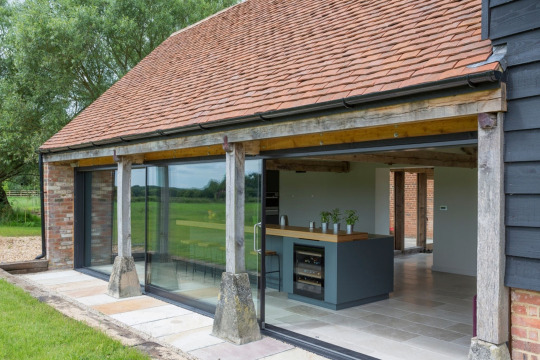
Why are Barn Conversions so Popular?
Barn conversions are becoming more common in the UK, and can be a really great investment with converted barn prices soaring.
Surprisingly enough, a barn conversion presents the opportunity to create flexible living space that can adapt to the needs and demands of modern family life. So, if you’re looking for somewhere to convert, raise a family and then sell for a sizable profit, barn conversions can be a great investment for you.
Besides, barns are often in rural areas, so if you’re looking to live away from the city life but still want an existing structure with a track leading to it and some form of foundation, a barn can be great.
Here’s another way to think about it: architecturally barns can also be outstanding structures, and their conversion can create the opportunity to design a contemporary/modern dwelling that retains agricultural design and style elements.
For example, you can convert stone barns or wooden barns, rustic barns, traditional barns, timber-framed Victorian barns and modern agricultural buildings by using the original materials in a way that honours them and appreciates them.
Because barn conversions offer a wide range of opportunities for transformation, your architects can work to the specific shape of the building, and if you’re the one who wants to start the process and owns the barn, you can have whatever design you want in the barn. So, you can have your barn conversion tailor-made for you, your needs and your requirements.
But that’s not all… Changes in legislation over the past decade have made barn conversions easier to build and give owners more freedom and less red tape. We’ll go on to discuss this later, but there’s never been a better time to buy and convert a barn – or finally do something with a disused barn on your property.
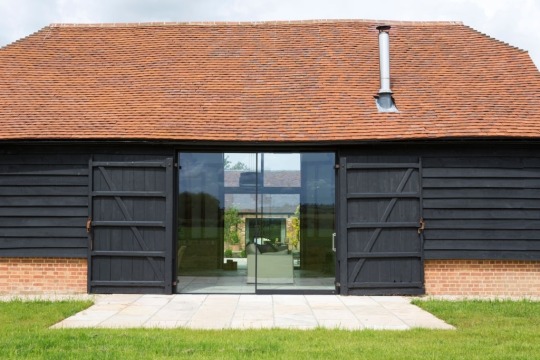
Class Q Permitted Development Rights for Barn Conversions
If you’re looking to convert a barn into a house, the good news is that most of the barn conversions fall under permitted development rights. This means you are not required to submit a full planning application, which is one of the main hurdles you must tackle during the traditional planning process.
In essence, Class Q permitted development rights seek to speed up the planning process and get new homes into the system at a much quicker rate than the traditional planning process. The rights present a fantastic and unique opportunity to repurpose a disused or neglected building into something extraordinary.
All you need to do is submit a Prior Approval application to regularise the conversion of your barn to ensure that it is both legal and that the council is fully accepting of the proposal. Therefore, it is essential you receive prior approval from the local planning authority before you proceed with any works on your barn conversion. Failing to do so, could create problems for you later on down the line.
In short, Prior Approval for a barn conversion allows the local planning authority to consider the proposal and their potential impacts on transport and highways, noise, contamination, flood risk and how these could potentially be mitigated. It also covers the walls, windows, roofs and materials of your agricultural barn conversion. As standard, the local planning authority will issue their verdict within 8 weeks from submission of your Prior Approval application.
If you don’t seek consent for your barn conversion, you may land yourself in some hot water when you come to sell the property in the future. Therefore, to avoid any complications or needless further down the line, we would always advise submitting a Prior Approval application as soon as you are able. Make no mistake about it!

How to Make a Prior Approval Application for Class Q?
Permitted development rules for barn conversions are complex and full of little nuances, occasionally making it difficult to meet all of the necessary requirements to qualify. The legislation sets out a very specific set of conditions that must be met before you can start converting your barn.
It is crucial that you submit a meticulous Prior Approval application for your barn conversion and prove that your proposal falls within Class Q permitted development rights. In the first instance, if you fail to adequately demonstrate that you have met all of the criteria, and the council subsequently reject your application, it can be extremely difficult to prove otherwise in future applications.
Recent changes made to Class Q permitted development rights also now require applicants to provide drawings with a greater level of detail. This includes:
Floor plans
Elevations
Natural light assessment
Door, window and wall dimensions
Proposed use of each room
Come April 6th 2021 all barn conversions will have to comply with minimum space standards, meaning for new residential units to be created under Class Q permitted development rights, all proposed habitable rooms will have to meet a minimum standard set out by the government. However, currently you are able to convert your barn into:
Up to 3 larger homes within a maximum of 465 square meters; or
Up to 5 smaller homes each no larger than 100 square meters; or
A mix of both, within a total of no more than five dwellings, of which no more than three may be larger homes.
In order to qualify under permitted development rights, your barn must be able to meet all of the following criteria
The barn must have been used in agriculture on 20th March 2013 – or within 10 years of you applying to convert it. You are not allowed to build a barn and convert it straight away – new barns must exist solely for agricultural use for at least 10 years before they can be converted. The agricultural use may have stopped before March 2013, but it can’t have had any other material change of use since this time.
The building must not be listed – if your barn is listed by Historic England that you will not be able to convert it under PDR, you will have to apply for a separate application called Listed Building Consent.
The building needs to be structurally sound – You can add reinforcements to help support the building. Essentially the existing structure must in structural terms be capable of functioning as a dwelling.
The barn must reflect the original use – This means that the overall character of the new conversion must make clear its previous use as an agricultural building or barn. You are allowed to add windows and doors, but only where reasonably necessary.
The barn must not be in a Conservation Area, National Park, Area of Outstanding Natural Beauty or in the Green Belt – if your barn is situated on land within any of these designations, it is not a suitable case for conversion under permitted development rights.
There are numerous benefits to taking the permitted development route for a barn conversion. As well as it being cheaper and quicker, you will have to provide less supporting evidence to the council than a traditional planning application would require.
Most importantly your conversion will not have to comply with local planning policy and design guidance. This means there are fewer hoops for you to jump through and your proposal will be subject to less scrutiny. Arguably, this gives you more freedom and flexibility to create something bespoke, unique and outstanding.
For instance, isolated homes within the open countryside are not usually permitted and are regulated against. However, if you have an existing agricultural building that meets all of the criteria for Class Q permitted development rights, this is a valuable loophole in the planning system that can provide you with a house in the open countryside.
Under Class Q, creating a new home is acceptable… regardless of the sustainability or desirability of the location of the barn (as long as it’s not in a protected area – see point 5 above). Therefore having an existing barn or agriculture building can be a major asset and something which should be taken full advantage of.

When do I Need Planning Permission to Convert a Barn into a House?
Full planning permission is required when your barn does not meet the requirements set out in Class Q of permitted development rights. In this scenario, you will have to submit a full planning application to your local council to seek consent to convert your barn.
For example, you will require planning permission to convert a barn if it sits within an Area of Outstanding Natural Beauty (AONB), a conservation area, a National Park, a Site of Special Scientific Interest (SSSI), the Broads, a National Park or a World Heritage Site.
Obviously, all of these land designations are there to prevent the inappropriate development of protected land. This means that any proposal to convert a barn within protected land will have to be heavily scrutinised and deliberated on by the local planning authority.
In order to carry out a thorough assessment as to whether this would be deemed as acceptable development, a full planning application with supporting evidence will need to be submitted.
Needless to say, if you want to secure planning permission for your barn conversion, you must ensure that you have put together a strong case to convince the council that consent should be granted for your proposal. In order to maximise your chances, you should ensure that your design:
Is in keeping with its original surroundings
Maintain the character of the original building
Respect protected wildlife species and their habitats
To put it in a nutshell: gaining planning permission for a barn conversion is a much more subjective decision made by the council, with the taste of the officers or planning committee becoming a factor. Permitted development, meanwhile, consists of rules that you can tick your way through.
Applying for planning permission requires you to build up your case, showing the council why they should award you with planning permission for this project.

Do I Need Building Regulations Approval to Convert a Barn?
All barn conversions, regardless of their size or use, require Building Regulations Approval. So how do you show you are complying with building regulations?
This is the part where you will need a good architect and structural engineer to assist you to submit your building regulations drawings for building control approval.
There are two ways you can make a building regulations application for your barn conversion, either by making a Full Plans Building Control application or by submitting a Building Notice.
However, we would highly recommend you to use the route of Full Plans Building Control application because the Building Notice route will not give you the protection and reassurance that a Full Plans application would provide.
When applying using the full plans route, your architect will require to submit a full set of technical and building regulations drawings for your barn conversion including site location plan, floor plans, elevations and vertical sections through the barn showing constructional details. Those plans should be accompanied by supporting structural calculations, specifications and construction notes.
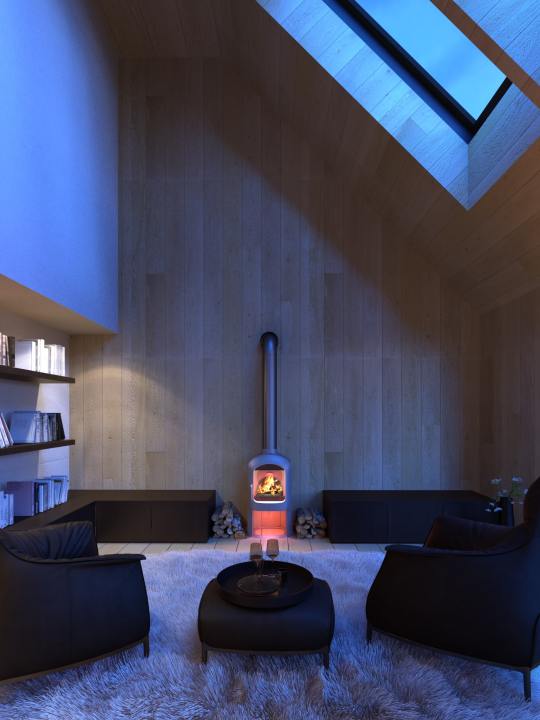
Barn Conversion Ideas: How to Design Yours?
Well, let’s start with the barn!
If you’ve got one in mind, walk around the site. Think about things that you’d like to include, things you’d like to keep and things you’d like to avoid. Note these ideas down: being clear with your architect is the best way to get a barn conversion that you’re happy with.
Also, remember that you’re starting with an existing building. If you wanted to knock it down and start over with something new, that’s fine – but this article isn’t for you!
The truth is your transformation should create something that includes both its original elements and what came before so you can make something wonderful. Incorporating the original elements of the barn does not mean that you cannot achieve a contemporary barn conversion design. Indeed you can.
Bear with us, because we’re going to show you how…

Barn Conversion Exterior Design Ideas
If you’re looking for a barn conversion, there’s a good chance that you’ll use a search engine online to look up information and instead be overwhelmed by different pictures of beautiful buildings. Sounds familiar?
Quite simply, the exterior of your barn should be both practical and appealing. It should keep out the wind and rain, support the rest of the building and everything else.
If you’re looking at a stone barn conversion, you might want to keep some of the original stonework: aside from looking good, it’ll act as a great insulator and help you stay cool in the summer and cosy in the winter. Those features are, as you might expect, rustic and gorgeous. Keeping that in the building’s facade helps to create a home that feels beautiful.
By contrast, you can also incorporate contemporary and sustainable materials into the building envelope, and rely on efficiency and passive design measures. By doing this, you can minimise life-cycle environmental impacts, enhance indoor environmental quality and reduce maintenance requirements.
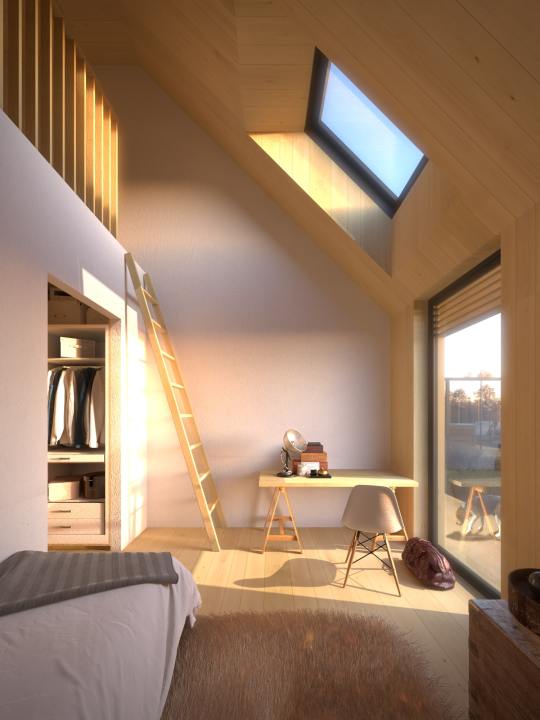
Barn Conversion Interior Design Ideas
If you’ve ever been in a rustic and traditional barn conversion, you’re likely to notice exposed timber beams over the walls and ceilings. It’s pretty obvious once you think about it… Keeping these visible is the vogue, but it’s also a great way to keep the memory of what the building was.
Similarly, some converted stables will keep the two-part doors (sometimes called Dutch doors) that brilliantly combine what the building is supposed to be ‘about’ – the harmony between the original elements – and the modern purpose that makes the building a home, office or studio.
Of course, there’s more to the interior than just the way it looks. Converted barns do tend to be open plan, but the new changes to laws mean that you can divide them up into rooms if you like.
Needless to say, converting a barn into a new use offers the opportunity to achieve an extremely beautiful transformation. For example, you can utilise gorgeous wood panelling and have high ceilings that allow for a lot of natural light and make the place very airy. This also makes the space feel light and refreshing and combines rustic senses and historical features with modern amenities.
There are also practical things, like making sure that the barn conversion is properly insulated, the roof is functional and weatherproof – the odd leak might be alright for a barn full of cows, but you don’t want that in your new home! Ultimately, your architect will come up with a design that shows off your barn’s original features and keeps it nice and suitable for people to be in.
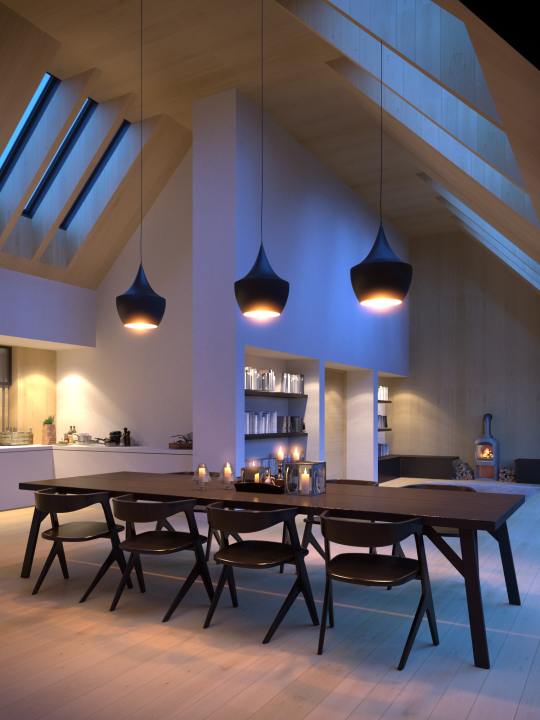
Contemporary vs Traditional Barn Conversions
As you might expect, there’s a lot of variety when it comes to barn conversions. The type of barn you’re converting – steel-framed, agricultural, modern, traditional stone – will all impact how you build and what you build.
You’ll also need to decide if you’d like the barn conversion to be contemporary or traditional, and if you want to use older materials and methods for a more old-fashioned look that honours the building’s past, or if you’d prefer something more up-to-date.
You should discuss the specifics with your architect because they’re likely to have all kinds of interesting insights into what makes your barn beautiful and functional.
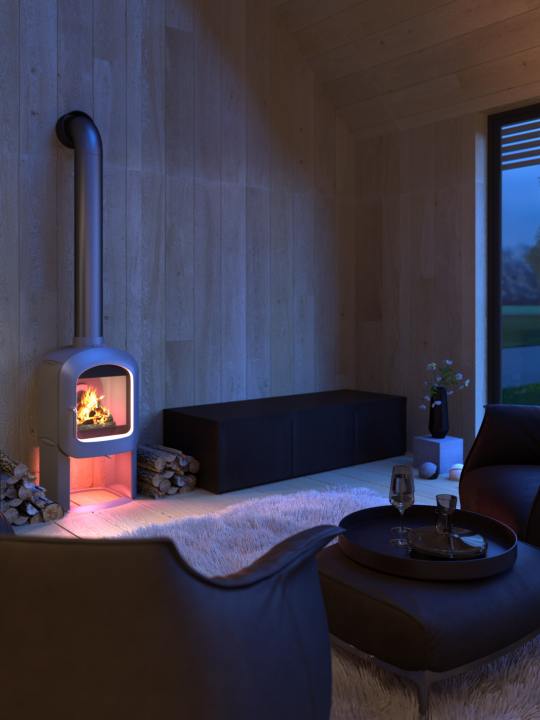
How Do You Find and Choose the Right Barn Conversion Architect?
Finding the right architect can be tricky. It’s the first big step in this process, and it’ll set up the rest of the project. You want someone trustworthy, reliable and good at their job and someone who will listen to your thoughts and ideas. After all, this will be your building: you need to like it!
Take a look online for reliable architecture firms with good reviews and relevant experience. Most of the architects will have portfolios of their work on their websites so you can see what they’ve done before – and you might be able to get some new ideas. Then contact the architecture firm and they’ll be able to arrange meetings and consultations to get the project started.
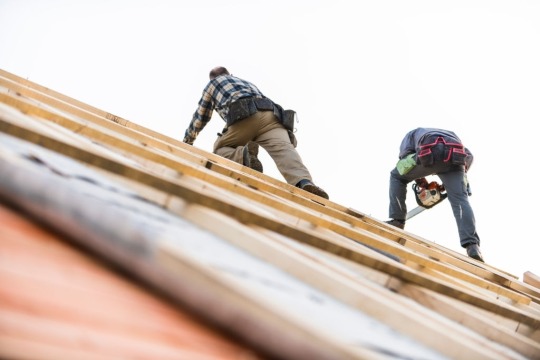
How Do You Find and Choose a Good Reliable Builder for Converting a Barn?
Like finding the right architect, finding the right builder is crucial for the project’s success. You’ll need someone you can trust, and someone who is reliable. Your architect may be able to recommend a good builder, or you can look into local firms.
There are a number of things you should check before committing to a builder, like the reviews, if they are a member of a trade association and you should ask to see some of their previous work.
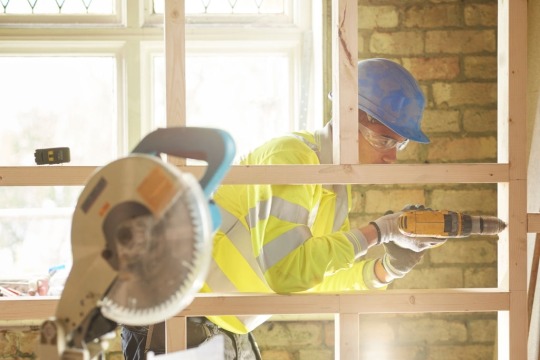
How Much Does a Barn Conversion Cost in the UK?
The average cost of converting a barn in the UK is generally estimated to be somewhere around £1,500 – £2,500 per square metre. However, the cost of barn conversions will also depend on the type of barn you’re converting: stone barn conversions are the most expensive, brick barn conversions are the cheapest and wood barn conversions are somewhere in the middle. Of course, this will depend on the barn in question.
We think that the benefits of having a beautiful building outweigh the costs, but if you’re on a tight budget this may not be the right choice for you. In some cases, it might become more expensive to convert a barn than it is to build something completely new.
You should be aware that if you are a private individual and not a business you can reclaim VAT paid on labour and materials that get used in your barn conversion. If you use a VAT registered builder (make sure you check this) they will invoice you with a VAT rate of 5%, instead of the normal 20%. If you buy any materials yourself, keep the receipts and submit them for a VAT refund. You have to do this quite quickly, though: this offer is only valid for three months after the barn conversion is finished.
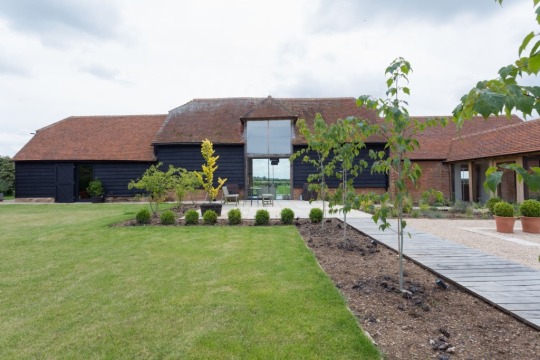
How Long Does It Take to Convert a Barn into a House?
Most barn conversions take around a year to complete – however this will depend on the barn in question and the amount of work you would like done.
We recommend speaking with your architects and builders to get a good idea of how long it will take for you specifically, and remember to take several variables including the complexity of the design, extent of structural works (and whether you will need need a new foundation or not) and level of fixtures, fittings and material finishes into consideration.
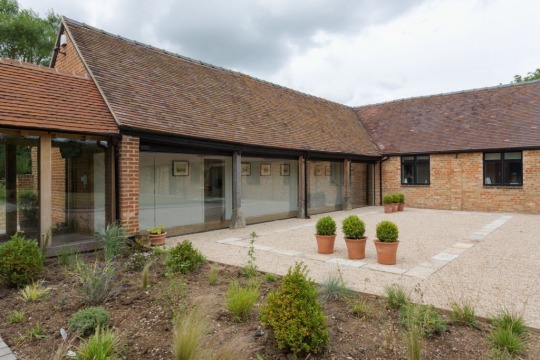
Can You Extend a Barn Conversion?
You can… sometimes. However, firstly, we’re not actually sure if you’d need to, because barns tend to be, by definition, extremely roomy already. Barns can be divided into more than one dwelling, but if you just want one large house you’ll probably already have space for everything within the existing structure.
If you still wish to extend your barn, then, unfortunately, one of the most important restrictions on barn conversions is that you are not permitted to extend beyond the existing footprint of the original barn.
Let’s face it: additions to your barn of a significant size are unlikely to be looked upon favourably by the local planning authority. Modest extensions may be deemed acceptable, such as those linking the barn and other outbuildings, but only if they are designed appropriately.
If you wish to provide additional space for a garage, then this may be permitted if it is designed sympathetically with the barn. Essentially this means it must be designed to replicate the appearance of a stable or other agricultural building.
But one thing’s for sure… If you are keen to have an extension, you will be required to submit a full planning application. This is because under permitted development rights you are restricted to converting your barn within its original square footage. It is important to note that it is easier to gain permission to extend your barn at a later date, once the conversion has taken place.

How Urbanist Architecture Can Help You
Now you should have a thorough understanding of how to successfully convert your barn into something truly unique and architecturally outstanding using Class Q permitted development rights.
The truth is, rates of refusal are high for barn conversions – however with the right professional backing and with the best planning team on your side, you will hugely increase your chances of success. While, on the face of it permitted development rights may seem simple, rarely anything in planning is simple. However, navigating them successfully can result in a modern barn conversion to be proud of.
If you would like us to help you design your conversion and create an exemplary transformation, please don’t hesitate to get in touch. We have worked on dozens of countryside projects and we can help you turn your barn into a home, office space, studio, bed and breakfast and much, much more.
We are a good fit if…
You prefer a custom, one-size-does-not-fit-all approach.
You are passionate about good design.
You are interested in massively effective projects that are delivered on time and need minimal revisions.
You need an expert, strategic, multidisciplinary chartered architecture firm, and not just the cheapest provider.
You are more interested in receiving an exceptional service than a low-end, perfunctory one.
You want to work with a firm who will fearlessly stand with you as true believers in your proposal’s mission.
[contact-form-7]
The post Barn Conversions: Planning & Class Q Permitted Development Rights appeared first on Urbanist Architecture - London Architects.
source https://urbanistarchitecture.co.uk/barn-conversion/
0 notes
Text
House Extension Cost in London: How to Calculate Yours?
We got a call recently from someone who had just bought a house. The house came with planning permission for a rear extension, which she was interested in having built. One of the questions she wanted to ask was: “How much will this extension cost?”
And it was a question we could start to answer because we knew how big the extension was, what kind of structural work was needed, whether the design would need particular construction skills and what some of the potential complications of the plot were. Plus, of course, the previous owners had taken care of the cost of getting planning permission.
In this article, we will help you with what you need to factor in to work out the cost of your extension. We will walk you through the whole process of calculating the build cost of your home extension and finish up with some rear life examples.
You will learn all of the easy steps to you need to implement to build your extension with minimum stress, complete your project on time and avoid budget blowouts. You will also be able to download the ready-to-use cost analysis spreadsheet template so that you can can calculate your house extension price for FREE.
So let’s begin…

Fact: Not All Home Extensions Are Equal
We could tell you that the average cost of an extension in London is generally estimated to be somewhere around £40,000 – £50,000. But that won’t tell you the cost of extending your home. For that, you’ll need to think about exactly what it is that you’re planning to do. But more about that later…
In general, we tend to discuss house extensions as if they were one thing. Why is that?
In reality, an extension can add a modest 4sqm to a home or it could – at 93 sqm – be bigger than the original house. (Astonishing, isn’t it?)
And, there are front extensions, side extensions and rear extensions, or any combination of these. Most are one storey, but we have done four-storey extensions.
Besides, loft conversions are extensions, too, but we’ve got those covered in another post, so here we will concentrate on building out horizontally.
So let’s take a closer look at how to calculate the real cost of building a house extension in London…

The First Sums of Building a House Extension in London
As a rule of thumb, building a home extension in London – just the shell – is going to cost you at least £2,000 per square metre. So, the cost of a 20 sqm extension would start from £40,000 (not including VAT).
However, the build cost of a house extension in London will depend on several variables including the complexity of the design, extent of structural works and level of fixtures, fittings and material finishes.
Here’s the most important part: In order to have a sense of what you need to budget for your extension, you first need to work out how big your extension is going to be. As well as price of an extension, the factors that can dictate the size of an extension include:
What’s the purpose of your extension? (This is a crucial question that occasionally people ask themselves far too late in the journey).
Are you aiming to build it using permitted development?
How far can you go without blocking sunlight from reaching your neighbours’ windows?
How much of your garden are you willing to give up?
The answer to some of these questions may well change when you get an extension architect involved. On the one hand, your architect may have to dampen some of your expectations based on their knowledge of the planning rules.
On the other hand, they might well be able to propose imaginative design solutions that mean that you can get more room more efficiently than you had expected.
But for now, using a tape measure (or a measuring app, if that’s more your style), work out how many square metres what you want to build is going to be.

What Else Do I Need to Price Up for a House Extension?
Costing a home extension, though, isn’t just a matter of knowing how much you’re going to pay per metre for construction materials and labour. But you know what else?
The truth is you have to think about how much it is going to cost to get you to the stage where you are ready to start building. You have to think about what you are going to put into your extension. And you should also be thinking about how the extension is going to integrate with your house.
Start by asking yourself this question: Do I want to take this opportunity to make changes to the layout of the rest of my home?
For instance, if you are building a kitchen extension, what are you going to do with the room where you used to cook? Or if you are building a wraparound extension, how you are going to create a open-plan living dining area?
At the very least, you will need to optimise the layout of your home and there’s a good chance you might want to knock down an internal wall or two to expand your living room or maybe add a wall to create a utility room.

Design, Planning Permission and Building Regulations Approval for Extensions
Yes, this is where we come in. Someone will need to design your extension, although – as we have said – the level of sophistication varies hugely.
What you need could be a simple box. Or, if it’s, say, an extension to a listed building, what you will require will be a design that is backed up by detailed heritage research and deeply sensitive to the history of the house.
Your extension will also need to meet planning regulations. If it’s small – eg, under 3 metres for a rear extension to a terraced house – it’s just a question of obeying the permitted development rules.
If it’s bigger than that – under 6 metres (or 8 metres for detached properties) for the same type of project – then you need to inform the council, who will consult with your neighbours.
And if it’s larger than that again, you will need to put in a planning application, for which the council will charge you £206 if you are a homeowner.
You will also need building control drawings for building regulations approval for house extensions. All this will need to be added to the price.
We think you should make provision for at least £4,000 for architect, planning and specialist services to cover full planning permission if you need that, £6,000 for architects and structural engineers to cover building regulations and technical drawings, £700 for building regs fees plus up to 10% of construction cost if you use a professional for contract administration and construction inspection.

Beware False Economies with House Extension Costs
Yes, it’s possible in the short term to trim some of these costs. But keep this in mind: working with cowboy builders and achieving a badly designed and built extension can drop the price of your home and end up costing you much more than you saved on your ‘cheap’ extension.
A word of caution: Not getting good planning advice and pushing ahead with permitted development without having a good understanding of the rules could leave you with an extension that the council slaps an enforcement notice on and may even order you to demolish. That’s quite a challenge.
In short, saving a couple of thousand pounds on the cost of an extension can sound tempting but might end with you having paid for £30,000 for something that is then reduced to rubble. That is not smart money management, make no mistake about it!
What Do You Want to Do with Your Extension?
Ask yourself these questions:
What are you doing with your extension and how will that affect what you spend?
Imagine you are extending your bedroom and won’t need any new furniture. The prices are mostly connected to the cost of construction and decoration. But with other rooms, you need to think about the appliances or equipment involved.

House Extension by Urbanist Architecture

House Extension by Urbanist Architecture
This applies to kitchens and bathrooms, yes, but also cinema rooms or gyms. Even for bedrooms, you should be thinking about whether you want to create built-in storage and adding that to the budget.
Let’s look at it in detail…
Cost of Bathrooms When Building an Extension
It’s unlikely that you will end up spending less than £2,000 on a sink, toilet, bathtub or shower stall and taps and shower plus cabinets or shelving, mirrors, lighting etc.
How much more than that you spend is up to you – your floor could be vinyl at £5 per square metre or top-range marble at £100/sqm. Right?
For example, a smart shower you can control with your phone will start from £600 and a high-end bathtub will be £1,500 and up. A high-end heated towel rail will cost you more than a grand. It’s not difficult, then, to see how you could spend £15,000 or more.
Cost of Kitchens When Building an Extension
Likewise, the average cost of a new kitchen (which, in the UK in 2020, is somewhere in the £6,000-£20,000 region) is not a particularly useful guide because the range of what’s on offer is so vast.
For example, a kitchen from Howdens may cost around £6,000 but from Poggenpohl can cost around £100,000.
You can get perfectly decent kitchen units and appliances together for £6,000 but equally, you can spend £2,500 on a fridge-freezer alone and £15,000 on an Aga. It follows that you can spend more on what goes in a kitchen than you spend on the shell.
But the silver lining is that it’s worth thinking about making sure that your built structure is at least as high a quality as what you are putting in it. What’s the point in having beautiful custom-made kitchen units if they end up warped or rotting because of damp caused by poor construction?
Cost of Flat Roof Extension vs the Pitched Roof Extension
To begin with, a flat roof is generally cheaper than a pitched one. This is because a flat roof is simpler to build. So whether you have a flat roof or a pitched roof on your extension will affect the building cost.
In general, there is a widespread belief in the UK that pitched roofs are superior and will certainly last longer because of the way they let rain run off. Meanwhile, there are now thousands and thousands of flat-roofed buildings in the UK that have lasted 60 years or more without any serious problems.
Surprisingly enough, it might just be possible to build a pitched roof with concrete tiles that comes in near the price of a flat roof. But once you go beyond that, prices start increasing.

House Extension by Urbanist Architecture

House Extension by Urbanist Architecture
For instance, slate tiles (and if they are from Wales you will pay a premium so stick to Spanish XD), crittal doors and windows, metal cladding (zinc) and some clay tiles will bump up the cost of a house extension…
And don’t forget that a pitched roof has more roof area, therefore it needs more material (finishing and insulation). Also, the more complicated the roof shape, the more expensive. Beyond that, if you have dormer windows, ridges and valleys, you will need to build it in a traditional way and carpenters are expensive.
Above all, you should also know that whether your preference is for a pitched roof extension or a flat-roof one, the final choice might not be yours to make.
Many councils specify in their design guides that the roof pitch on the extension should echo that on the original house. Personally, we think that’s a simplistic and unimaginative approach but it’s one that we – and you if you’re in one of those areas – have to work with.

Cost of Extension Spreadsheet
How Much House Extensions Cost: A Detailed Example
We thought you might be interested in seeing what you are actually paying for, so we’ve based the breakdown cost of building a rear single-storey kitchen extension that we designed and provided contract management for. The table below gives a summary of the prices, which work out at around £2,500-3,000 per sqm for the structure.
If you want to dig into the item-by-item cost at construction, you can use our Cost of Extension Spreadsheet template. Please note, this is not meant to say that every extension of this size will cost this much – it’s meant to let you see where the money goes and allow you to budget realistically for what you want.
Professional services and council fees (up to planning approval)£5,006.00Professional and council fees (building regulations, tender, contract management)£15,980.00Annual mortgage interest on £80,000 borrowed to fund extension£1,600.00Preliminaries (including site supervisor, removals and professional cleaning)£8,636.00Demolition£993.51Substructure£11,615.80Structure£3,322.97External walls£8,158.06Ground floor£1,464.13Warm flat roof£3,857.70Drainage£2,352.00External window, rooflights and door£6,901.73Internal doors, skirtings, architraves & joinery£586.34Water services/plumbing£2,466.00Mechanical and electrical (including gas connections, radiators, plug sockets)£5,517.01Wall preparation & finishes£8,181.04Kitchen units and appliances£9,307.00Total£95,865.29
Breakdown Cost of a Single Storey Rear Extension
As an alternative to using the spreadsheet, you can use our sophisticated Build Cost Calculator to give you a sense of your anticipated budget. The calculator will help you quickly calculate construction cost of your extension and give you the insight you need at the preparation and planning permission stage of your development.
The estimated build cost shown on the example above or the one you will get using the Building Cost Calculator will give a very good indicator of the likely prices for extending your home – but do remember it is always possible to further save on these costs by planning ahead, engaging a well-established residential architecture company and choosing the right builder.
Think Long Term
Our point is this: We think a house extension should be a high-quality construction that lasts. It should make your home a better place to live in now and in 20 years’ time and also add financial value to your property.

House Extension by Urbanist Architecture
For those reasons, it is worth investing money in (and it’s almost certainly much cheaper than moving). If you can’t or don’t want to spend that much right now, it might be that putting up a shed in the garden to use as storage, playroom or office is your best option. And then, when your finances are stronger, build the extension your home deserves.

How Urbanist Architecture Can Help You
Urbanist Architecture is a London-based RIBA chartered architecture and planning practice with offices in Greenwich and Belgravia. With a dedicated focus in proven design and planning strategies, and expertise in residential extensions, conversions and new build homes, we help homeowners to create somewhere they enjoy living in and landowners achieve ROI-focused results.
If you would like us to help you design an extension that will transform your house, please don’t hesitate to get in touch.
We are a good fit if…
You prefer a custom, one-size-does-not-fit-all approach.
You are passionate about good design.
You are interested in massively effective projects that are delivered on time and need minimal revisions.
You need an expert, strategic, multidisciplinary chartered architecture firm, and not just the cheapest provider.
You are more interested in receiving an exceptional service than a low-end, perfunctory one.
You want to work with a firm who will fearlessly stand with you as true believers in your proposal’s mission.
[contact-form-7]
The post House Extension Cost in London: How to Calculate Yours? appeared first on Urbanist Architecture - London Architects.
source https://urbanistarchitecture.co.uk/house-extension-cost-london/
0 notes
Text
Wraparound Extensions: How to Design & Build Yours and Get Planning Permission
When homeowners are considering building an extension onto their home, they often think of a wraparound extension and side return first. But, why is that? What makes them so special?
In a nutshell, they enable you to fully utilise your space and reinvent your home while extending to the rear and side of your house. If you’re looking to build an extension for a kitchen or living / dining space, then this is the ideal type of home extension.
In today’s article, you will learn amazing design ideas to build a wraparound extension to maximise space, comfort and light. You will learn how to get planning permission with smart intelligent planning solutions.
You will discover the secrets of the most successful house extensions designed by architects and find out how to add a side return extension that will do more than filling a garden space on your property.
Want to know more about how to design a beautiful house extension, avoid budget blowouts and get planning permission with ease?
Bear with me, because I’m going to show you how…
What is a Wraparound Extension?
In fact, wraparound extensions are essentially a hybrid of side and rear extensions which form an ‘L-shape’ at the back of a property. As the name would suggest, a ‘wraparound extension’ literally wraps itself around two sides of your home, typically at the rear and adds extra width to your home. It can be a single height or double height.
Remarkably, depending on the size of your house and garden, a wraparound extension can usually add between 15-60m2 of space.
Beyond that, side return and wraparound extensions are also ideal for ground floor flats. However, in addition to other statutory consents which we will explain below, you may also need an additional permission known as License to Alter for extending your leasehold ground floor flat.
Want to learn more about side return and wraparound extensions?
Let’s dig a little deeper…
Why are Side Return and Wraparound House Extensions so Popular?
The simple truth is if you have redundant space on the side of your property, then building a wraparound extension is the perfect opportunity to expand your living space.
Believe it or not, building a side return house extension is a practical and often inexpensive way to add much-needed space and value to a property. And the layout options for a house extension are limitless; you can create an open-plan kitchen or add an extra bedroom. Astonishing, isn’t it?
As seen on other types of house extension examples, wraparound extensions are a popular expression of a range of architectural styles, both for traditional and contemporary house extensions.

Before

After | Creative Contemporary House Extension by Urbanist Architecture
But one thing’s for sure: By building an L-shaped side return extension, you can reconfigure the layout of your home dramatically, add a new functional kitchen or create distinct open-plan living and dining space.
But you know what else?
You can also achieve optimal space saving by using your wraparound extension to divide the space up into multiple rooms such as bedrooms, walk-in storages, utility rooms or bathroom. Imagine if you had a new space that you could do whatever you want with.
But that’s not all…
Most importantly, wraparound and side return extensions are popular for period houses – particularly Victorian houses, which are great family houses – as they maximise the available living space by utilising ‘dead’ space without eating into the size of your private garden.
Whether you want to add an extra bedroom to accommodate a growing family, add an office or dining room or extend your kitchen, a successful extension architect can turn your ideas into a workable design that will take full advantage of what your house has to offer, providing you with practical and functional space planning and remodelling with maximal square footage.

Permitted Development Rights for Side Return and Wraparound House Extensions
Under permitted development, you can extend along the side and separately at the rear without planning permission. However, as soon as these additions form the L-shape and join together, you will need planning permission.
So, all wraparound extensions, which form an L-shape along the side and rear of your home, require planning permission. They do not fall under permitted development rights.

Planning Permission to Build Side Return and Wraparound House Extensions
You might be wondering about planning permission, which can sometimes be the most complicated part of a building project.
Unlike most of the house extensions, adding a wraparound extension does not fall under permitted development rights and therefore you will require to submit a householder planning application to seek planning permission.
Remember: When you submit a planning application, the local planning officers will only take certain issues into account. These are often referred to as ‘material planning considerations’.
For single storey or double storey wraparound extensions, you and your architects will need to carefully consider the following:
Loss of light or overshadowing
Visual amenity
Effect on listed buildings and the conservation area, if it is in one
Impact on the character or appearance of the area
Scale and dominance
Overlooking/loss of privacy
Design, appearance and materials
A word of caution: When your extension architect is developing your design, they need to pay particular attention to these matters to ensure your application has the right components to secure planning permission for a wraparound extension.
The truth is, in order to give your project the best chance of being in line with the requirements of planning policies and to prevent you ending up in a repeating cycle of having to reapply, you should always consult an RIBA-chartered practice or an RIBA- chartered architect early on and avoid working with unqualified architects or online architectural firms.
Here’s a clue: By working with successful residential architects, you will receive the best independent advice, achieve bespoke extension design and get high-quality planning drawings for your wraparound extension. Imagine what it would be like!

Your architect will develop a design that is more likely to get planning approved the first time around. In essence, you can transform your relatively compact space into a beautiful, spacious and functional place.
Needless to say, as well as helping you with the side return extension design and planning permission, your architect can also recommend reliable contractors that would be suited to your extension project. And you’re set!

Do I Need Building Regulations Approval to Build a Wraparound Extension?
All house extensions, including wraparound and side return extensions, require building regulations approval. In order to show that you are complying with building regulations for your extension project, you need to submit wraparound extension building regulations drawings for building control approval.
But first a warning: Due to the nature of a wraparound extension, you will typically have to remove the original rear wall of your property, as well as your existing side return. Removing these walls will require temporary propping systems and failure to get this right may cause your property to collapse.
On the face of it, you also will require a new structural design to provide structural integrity for your new home extension. Hence why you will not only require the input of an architect for your building regulations and construction drawings but also a structural engineer for your structural calculations and specifications.
Wraparound Extension Ideas: How to Design Yours?
Have you ever found yourself thinking about designing your wraparound extension?
I’ll walk you through the whole process of coming up with creative design ideas for home extensions.
To start with, picture this: You can think of your wraparound extension as a simple L-shaped box when designing your new space. However, you need to employ smart space planning solutions that allow you to make the maximum advantage of extension without compromising comfort or aesthetics.
Whether you just want to enlarge your living space and update your kitchen or add a children’s playroom or study area, you need to formulate clever design ideas and develop concepts for each and every part of your extension to be used to make your home more attractive and comfortable. It sounds simple. And it is.
Here are some examples you can copy/paste today for your house extension:
Some wraparound extension functions include:
New kitchen
Open-plan living-dining
New Bedroom
Utility room
Bathroom
Children’s playroom
Study room or office space
Open-plan dining area
Informal lounge
Some wraparound extension design ideas include:
Idea 1: Conservative design with matching materials to make it blend in with your house
Idea 2: Radical design with zinc cladding to create contrast
Idea 3: Traditional design with roof lanterns to increase the daylight inside your house
Idea 4: Minimalist design with plain elevation finish to create a seamless look
Idea 5: Contemporary design with large sliding doors to add more natural light and embrace your outside space
Idea 6: Industrial-style design with exposed brickwork

House Extension designed by Urbanist Architecture
How to Maximise Light, Space and Comfort?
Most of the time, homeowners add wraparound extensions to create spacious and bright open-plan living and dining spaces. But how do they achieve that?
First, you will want to think about getting the maximum light into your space.
Quite simply, brightening your space can make it look more inviting and spacious, which is why solar orientation (i.e. thinking about where, when and how sunlight will enter your room) is so crucial.
The secret is that your architects need to design your side return extension in such a way that you are getting natural light and are in the sun’s path throughout the day.
Needless to say, one way of ensuring you are maximising your available natural lighting is to use large glazing. For instance, you can invest in structural glazing to turn your exterior walls into floor-to-ceiling windows.
And, if you want to keep a little privacy, then a full height bi-fold or sliding doors made of glass will bring natural lighting throughout the day and open up your space.
Beyond that, lighting is also a factor to think about when you are looking to make your extension feel spacious. For instance, a few cleverly placed light fixtures can give the illusion of a much larger space.
Here’s a clue: Distribute the light fixtures across your extension and choose fittings that match with the aesthetic of your wraparound extension so that you can give light every corner of your space.
Perhaps unsurprisingly, while everyone loves a chandelier, if you want to maximise your space, then compact light fixtures are your friend. Choose a streamline modern pendant light fixture as your primary light source and add on more compact spotlights across the room.
Just like you might take the top down on a convertible to enjoy the sun, you can add a skylight to get the most out of your natural lighting. Working with your architect, you can decide just how large a skylight you want to add.
Perhaps unsurprisingly, we recommend placing your skylight over the heart of your wraparound extension, such as a kitchen or dining table. By doing this, you can brighten the whole room. Just imagine that…
Here’s another big idea: You will want to feel comfortable in your new space, and choosing the right furniture is the first step. You should select pieces that compliment the design and shape of your home extension, and that work with the design style that you have chosen with your architects. It couldn’t be easier!

But that’s not all…
To maximise your comfort, consider expanding out into your garden. A decking or patio area can seamlessly connect your outdoor living space with your home and is ideal if you want to host gatherings during the warmer months.
Just think how great it would be to utilise the comfort of your extension and a patio if you were to host a summer BBQ or drinks party.

House Extension designed by Urbanist Architecture
Internal Layout Arrangement: New Kitchen and Open Plan Living and Dining
Can you imagine the new layout of your home with the addition of your home wraparound extension? Are you picturing your dream kitchen yet?
The truth is if you have a growing family then it’s likely that you’re starting to run low on interior space. Don’t worry. There’s a solution, and you know that!
A kitchen side return extension is a great solution for large families, as you can take an inefficient layout and transform it into a functional living space. When you are space planning, we recommend looking at open-plan living to utilise your new space.
Similarly, kitchens are one of the most popular rooms for wraparound extensions, allowing you to not only get a larger and more functional kitchen, but it also lets you repurpose that space in your home as a utility room.
In addition to that, working with the L-shaped plan of a wraparound extension, you can use the side corridor as a dining area and utilise the section at the rear as a kitchen with a large island and all the storage you could need.
On top of that, you can maximise your open-plan space with a pitched roof and large windows, especially if you utilise a sliding glass door. With a side return extension, you can finally get the kitchen and living space of your dream.
And the best part?
The L-shaped design provides enough flexibility for the new space to serve not only as a kitchen but as a lounge and dining area. Utilising the wasted space on your property can allow you to reimagine the internal layout of your home.
Now it’s your turn to start imagining what your space could look like.

House Extension designed by Urbanist Architecture
Adding a Wraparound Extension to a Listed Building
Good news!
If you’re lucky enough to live in a listed building, then you may be curious about whether you can build an extension. While this isn’t impossible, it will take more professional care and attention than if you had a more modern home. Ever wondered how?
Let me say this straight: You will need to work with experienced listed building architects, planning consultants and contractors to preserve your listed building’s historical assets, including its structure.
And, before putting in your planning application for a listed building extension, you will have to consult historical records to include accurate descriptions of the heritage of your listed building.
While it’s certainly not impossible to add a side return or wraparound extension to a listed building, you will have more hurdles to jump over.
What it all boils down to is: You will need to have a plan that shows the existing structure, along with your wraparound extension drawings including floor plans, elevations and sections, and complete relevant documents such as a Heritage Impact Assessment and Design and Access Statement.
At Urbanist Architecture, we have worked on numerous listed building projects so we know the requirements of renovating a listed building inside out. We can advise you on the best course of action to successfully get your Listed Building Consent application approved and to get your wraparound extension design off the ground.

Adding a Wraparound Extension in a Conservation Area
To begin with, conservation areas were introduced during the 1960s to protect and preserve the character of a local area due to its unique architectural or historical character that needs to be preserved under Section 69 of The 1990 Planning (Listed Buildings and Conservation Areas) Act.
Let’s face it: Building a wraparound home extension in a conservation area means that your planning officers will take a long hard look at your plans. So, it is very important for you to work with an architect and planning consultant who has experience in securing planning permission in a conservation area.
But here’s the interesting thing: The planning officers often believe passionately in the area they look after, so you need to know what the area stands for and how you can preserve and enhance the way it looks and feels.
There are certain aspects of the area that are sacrosanct. How do you work out what those are?
Needless to say, this is where a successful team of chartered architects and planning consultants can help you navigate the unwieldy process of getting planning permission. They will have detailed knowledge about how to make this work for planning permission in a conservation area.
By and large, an architect and planning consultant with a detailed knowledge of working in conservation areas will be able to advise you on the most successful course of action and save you both time and money by critically telling you how likely your wraparound planning application is to be successful.
You will be glad to know that just because your home is in a conservation area, it does not mean that your wraparound extension has to have a traditional design. There is nothing wrong with a contemporary home extension. You don’t have to build something that is exactly the same as what is already there.

Urbanist Architecture team discussing a residential project, designing simple, feasible and cost-effective design solutions.
How Do You Find and Choose the Right Extension Architect?
You’re ready to start, but you need an architect.
To begin with, you should set out a brief of what exactly it is you’re hoping to achieve with your extension. This doesn’t need to be a concrete brief, but it should have your main ideas, such as the style of wraparound house extension that you want, your budget and any unique characteristics about your home.
You can find an extension architect using the Royal Institute of British Architects’ ‘Find an Architect’ tool to help you begin your search. Or you can search them on Architects Near Me directory. Don’t be afraid to ask your friends, family or neighbours for recommendations of architecture firms that they have used previously as a recommendation from a trusted friend will always give you extra peace of mind.
Here are some things to keep in mind:
When choosing a good architect, it’s important to find a reputable architecture practice that is familiar with the planning restrictions and building regulations. The ideal extension architect should have a combination of artistic skills as well as an in-depth knowledge of planning policies and building regulations.
For instance: If you employ a multidisciplinary practice like Urbanist Architecture consisting of architects, planning consultants, and interior designers, then they will be well equipped to manage and oversee every aspect of the planning, design and construction, as well as handle any challenges that may arise.

Urbanist Architecture team carrying out periodic site visits and continuously monitoring and evaluating the construction to make sure that the building works meet the needs and aspirations of their clients.
How Do You Find and Choose a Good Reliable Builder for Building a Wraparound Extension?
Now you have an architect, but need a builder. Right?
The process to find and choose a good and reliable builder is similar to that of choosing your architect. It sounds simple. But it isn’t.
In most cases, your architect will be able to recommend a builder for you that they regularly work with though the Traditional Procurement route. But there are some methods you can use if you decide to choose one independently.
If you decide to choose one independently for your side return, we recommend that you follow strict criteria and use our Hiring a Builder Checklist to draw up a shortlist of contractors.
By using this checklist, you will be able to know whether or not you at risk of hiring a cowboy builder, learn the tests for identifying a reputable construction firm and get insights on how you can make sure you make the right decisions all the way through a construction project
Don’t forget: The most important thing when choosing your builder is to find out whether they have carried out a project like your wraparound extension before, check their references and keep everything in writing.
Make sure your architect will check their competence for you and build up a solid contract with start and completion dates, details about scope of work and payment plans. A good and reliable builder will have no issue with signing a Building Contract and will ensure that they take proof of payment. Make no mistake about it!

What Is The Cost of a Wraparound Extension?
Here comes the big question – the cost!
It’s almost impossible to give an arbitrary estimate for a wraparound extension cost, as this will depend on several factors. However, the average cost of wraparound extensions for a family home in London that we typically design ranges between £1,750 and £2,750 per square metre. So, for a 25sqm wraparound extension, you are looking to invest around £56,250.
Let’s dig a little deeper…
The build cost of your side return and wraparound extension will depend on several variables including the complexity of the design, the extent of structural works and level of fixtures, fittings and material finishes.
The price will be largely determined by whether your property is in London or the South East, which will increase your base price considerably. For example, if you are building in the North of the country, you can take advantage of traditionally cheaper costs to keep your budget more affordable.

But hang on a minute…
You will also need to consider the planning application fee, building control application fee and professional fees of architects, planning consultants, structural engineers and party wall surveyors.
Although the professional fees of architects vary according to your architecture firm, most of the reputable architects charge around 8-12% of the build cost for the whole process from conception to completion. Working with a cheap architect may sound tempting but can you afford if they fail?

How Long Does It Take to Build a Side Return Extension?
When thinking about the time it takes to build a side return or wraparound extension, you should consider it to be a three-part process that involves both developed design, technical design and construction.
Let us give you an example…
The average timeline of side return extensions for a family home in London that we typically work on takes roughly between 8 and 10 months, from conception to completion, depending on securing statutory consents without any delays.
In short:
Developed Design + Planning: 3 months
Technical Design + Building Regulations: 2 months
Contract Administration + Construction: 4 months
However, if you want to urge on the side of caution, we recommend allowing a year in total for the full design, planning and construction process.

How Urbanist Architecture Can Help You
At Urbanist Architecture, we are dedicated to committing ourselves to every design and build project. We know the trust that you place in us to help you deliver the wraparound extension of your dreams.
Whether you are looking for a wraparound extension to add extra bedrooms for your growing family, or you want to finally get the kitchen of your dreams where you can host all of your friends for dinner, we can help you get your ideas down on paper.
Unlike other architecture firms, we will provide you with 3D photo-realistic images to allow you walk through every detail of the design so that you can have the peace of mind that it is what you want.
As our client, your bespoke plans will allow you to design the extension that you have always wanted. Once we develop your planning drawings for your side return extension, we will work to get you the planning permission that you need to build your extension in London or anywhere else.
Just think how it’ll feel to show your new space off to friends and family and to be able to host your loved ones in a sparkly contemporary kitchen or informal lounge. You will want to have the champagne on ice for your first evening of hosting duties!
As we take a hands-on approach to our projects, we are limited in the number of home renovation projects that we can take at the one time. Our new project calendar fills up quickly, and if you are interested in getting your project off the ground, we recommend contacting us right away.
We are a good fit if…
You prefer a custom, one-size-does-not-fit-all approach.
You are passionate about good design.
You are interested in massively effective projects that are delivered on time and need minimal revisions.
You need an expert, strategic, multidisciplinary chartered architecture firm, and not just the cheapest provider.
You are more interested in receiving an exceptional service than a low-end, perfunctory one.
You want to work with a firm who will fearlessly stand with you as true believers in your proposal’s mission.
[contact-form-7]
The post Wraparound Extensions: How to Design & Build Yours and Get Planning Permission appeared first on Urbanist Architecture - London Architects.
source https://urbanistarchitecture.co.uk/wraparound-extension/
0 notes
Text
How to Hire Builders Like a Pro: 16 Key Questions to Ask
Few decisions you ever make can affect your finances as much as hiring a builder. Seriously, how can you make sure you are finding and hiring the right builder for your project?
Well, the secret could be asking the right questions to builders you are planning to recruit. But, what to ask a builder when getting a quote?
In today’s article, we are going to walk you through all of the essential aspects you should look into when you are hiring a builder in the UK, so you know that you are getting a safe, reliable builder to work with you through your construction process.
You will learn about the most important questions to ask when you set out to find and hire a good builder. Follow these easy steps to make sure that the building company you choose is the right one to carry out your construction safely, professionally, on budget, on time, and deliver the results you deserve.
So let’s start with the first question…
1. Is the builder you are hiring registered as a limited company?
To begin with, some builders are registered as limited companies. Have you wondered why?
This means that there is an element of separation between them as businesses and them as individuals. It works to protect and legitimise the builder and any dealings you do with them.
Good news: It also makes it easier to check on their past work. You should ask for confirmation that no claims have been made against the company in the last five years, so you know that they’ve got a good track record and can be trusted. Make no mistake about it.
2. Is the builder a member of any trade associations?
Quite simply, trade associations are groups for people of particular professions. It’s a good way to share new information about practices, policies and other things specific to that industry.
Needless to say, you should ask your prospective builder if they’re a member of a trade association, find out which one, and then confirm this with the trade association to make sure they’re active members.
A lot of people don’t know much about the building industry, so checking with experts is a good idea and a great way to ensure that they’ve got up-to-date knowledge and good experience.
Want to know more about how to make sure you will not appoint a cowboy builder?
Keep reading…
3. Does the builder have a registered gas engineer and an electrician in their team?
You might look at this and think that you won’t need a gas engineer because you’re not having any gas work done, or you won’t need an electrician because you’re not having any re-wiring. Sounds familiar?
In fact, it’s actually still a good idea to ask this question when hiring a builder, because contractors often come across unexpected things when working on buildings, and easy access to an expert is a great way to make sure that any potential issues are managed. Let me say this straight
Let me say this straight: You should ask your builder about all the members of their team, including the engineers they have in-house, and make sure that they’re all members of approved trader schemes and just generally reliable, trustworthy people. You’re about to give them a lot of money and access, and you can’t do that if you don’t trust them.

4. Does the builder have a site manager who can manage the build?
We’ve already said that you should meet the team before you hire anyone, but the site manager is definitely a priority. You should see how they manage and communicate with your architects during the construction work, and how they interact with you. Why is this so?
The site manager will be overseeing your building works, so they should have an overall understanding of how construction management works, and be able to run everything smoothly, effectively, on budget and on time.
Put it this way: The site manager should also be the kind of person you trust in an emergency, in case anything does go wrong.
5. Does the builder have any technical and support staff?
In general, depending on the size of the company, it’s not always possible to know everyone who works for/with your builder. However, it’s a good idea to have some idea of how many people they have on payroll and who they work directly with, including the technical and support staff.
Ever wondered why?
Reality is, these people will usually work in administrative capacities in the builder’s office, so you might not see them face-to-face every day, but knowing who to contact for paperwork, queries and invoicing is crucial.
Here’s a clue: You can ask for their CVs (like the on site team), if you like. Otherwise, an understanding of who they are and what they do should be fine. You should also have their contact numbers or email addresses in case you need to get in touch with them.
6. Does the builder you are hiring offer a guarantee?
We want everything to go smoothly and well. What could be more important?
Asking the questions laid out here is a good place to start! But it’s also important to have some backup in the form of a written guarantee that will be honoured by a UK-based insurance company. That way, if the company stops trading for whatever reason, you will be protected.
Again, be cautious and if you’re concerned that your builder won’t be able to do the job, see if you can find someone else. But an insurance-honoured guarantee is an essential backup, too.
In a nutshell: If you want to avoid cowboy builders and lower the chances of any headaches and extra costs along the way, we recommend hiring your architect to act as your contract administrator and construction inspector.
This means that your architect will carry regular site visits and continuously monitor your construction to make sure that the building works meet your needs and aspirations.
7. How long has the builder been in business for, and what relevant experience do they have?
There’s nothing wrong with hiring a new builder, and there’s no guarantee that people who’ve been in the business for years will be great. However, if someone’s new to the job or company, it’s a good idea to make sure the rest of the team are more experienced and that there’s a backup in case things do go wrong.
For instance, you can also ask them if they’ve worked on buildings like yours before, to make sure that they’ve got relevant knowledge. Again, ideally they’ll have done similar projects before but if they haven’t, at least make sure that someone on the team knows what to do. You should also ask to see a portfolio of previous work – but we’ll talk about that later.
8. Did the directors of the company ever dissolve the company before?
Sometimes, companies fail – we all know that. Debts build up, the economy doesn’t grow, or any one of a million other factors can mean that companies need to be dissolved.
If you discover that the director of the company you’re looking to hire has dissolved in the past, it’s not the end of the world, but you should investigate.
Did they leave work unfinished, or take money from customers and vanish?
Were there lengthy and difficult legal battles?
But the silver lining is previously dissolved companies aren’t automatically a red flag, but you shouldn’t ignore them either. If it’s happened more than once? Be extremely careful, and seriously consider using a different company.
9. Does the builder have the necessary insurances?
Public liability insurance: it means that if someone is hurt or something is damaged during constructions, the insurance company will pay you for the inconvenience.
Employers’ liability insurance: it is a requirement when companies (not just builders) start to employ people. It means that if an employee is injured or taken ill because of their job they will get compensation from the insurance company
Contractors’ all-risk insurance: this is the most important insurance as it protects your property and any third parties. Let me say this straight: You should not appoint a builder without Contractors All Risk Insurance and Professional Indemnity Insurance.
We all know that insurance is always important. We hope that nothing goes wrong, but it’s there just in case something does happen. If an expensive mistake is made, you can make a claim against the builder and their insurance will pay you.
My point is this: When you are hiring a builder, you need to check and make sure that your contractor has all three forms of insurance. Verbal confirmation is not enough: they should provide copies of the insurance certificates and evidence that they’ve paid their premiums.
If they can’t (or won’t) do this, do not work with them. This is literally a deal breaker: uninsured builders can get themselves, and you, in a lot of trouble.
10. Does the builder have an up-to-date health and safety policy?
Of course, it’s best for everyone that there’s a safe environment where insurance goes unused. When meeting with your builders, it’s important to make sure that they’ve got a comprehensive set of health and safety procedures and fire safety procedures.
You can get them to complete a health and safety questionnaire, and make sure you raise any concerns so they can be addressed and rectified.
A word of caution: Building sites can be dangerous places, so getting clear policies is a good way to protect everyone and make sure that nobody is put at risk.
11. Did the builder you are hiring show a sincere interest in your needs?
Broadly, you need to be able to get on with your builder. They should care about doing a good job, and you should be able to trust them. Talk about the budget, the quality of the work, and how long it’s likely to take.
Have some contingencies in place, too, because things might not always stick to the plan but it’s important that everything doesn’t fall apart at the slightest disruption.
The truth is your building is a valuable asset that you may well have to live or work in, so make sure that it’s well crafted and up to your standards. And consider how comfortable you’d be talking to them about any issues.
Good builders love their jobs, and they should be passionate about what they do. In turn, you should be enthusiastic about getting something new and nice. Remember that you’re working towards the same goal, and you need to have someone good at your side.
12. Can you get two (or more) references from the builder you plan to hire?
Let’s look at what they’ve done before! Obviously, anyone hiring will want to speak with previous employers about the candidate’s strengths and weaknesses, and builders are no exception.
The best thing to do is ask to see a portfolio of the builder’s previous work, and then contact the former clients to see if there were any issues with the quality of work, cost, timing or atmosphere.
Most importantly, you should also speak with the architects of the former clients, as they will have an insight into what happened or what was supposed to happen.
Finally, check out the builder’s reviews online. Pages like Google Reviews or Yelp should be a good place to start.
13. Can you get a written quote, including a fixed price and a summary of all the work that will be done, the materials the builders will use and VAT?
You might be wondering what to ask a builder when getting a quote? You are not alone!
Start with asking your builder if they can offer a written quote or fee proposal. Once you have received it, make sure their company name, company address, company landline number and company registration and VAT numbers are on their quote.
Most of the builders are interested in providing estimates. But what’s the catch?
Fixed Price vs Estimate
Estimates are a good place to start, but builders aren’t obligated to stick to them, so you should get this refined down to a fixed price before any building work begins. Imagine what it would be like to work with a builder who will increase the building cost half way through? You would find yourself in a never-ending battle…
Basically, your written quote should include a fixed total price, and an outline of what work they’re going to do and how long they’re going to take to do it. An estimate can sometimes just be a rough guess, so you could end up paying more and exceeding your budget.
Warning: Make sure that the fixed total price is not an estimate and that it includes a breakdown of all the work to be done and the materials used.
Material Cost
Before hiring a builder, get your architect to look over the cost of the building works, so you can clear up any issues before the builders start. Work out how much the materials will cost, who is buying them and where they’re getting them from. And which materials they’ll be using!
Here’s another way to think about it: Some builders might be able to get things at a wholesale price from distributors, but make sure that you’ve specified this and that what they’re sourcing is up to your standards.
Scope of Work
This is the part where most of the people fail… That’s quite a challenge for individuals who have not carried out a construction project before.
So, make sure that you understand what is included in the quote. If you’re not sure about something, look it up or ask your architects. The document outlining the scope of work will end up being pretty long, and looked over by the builders and the architects, so if possible see if you can meet and go through it together.
Especially when it comes to materials, the architects and builders will need to be clear on what is needed and what will be used. They should be upfront about this from the start, so that you don’t end up under or over-ordering anything.
If you are fully satisfied with all of the materials, double-check with your architect again about the scope of works, planning drawings, timescale, list of specifications and tender and building regulations drawings. This way you will also ensure that you fully understand what is included in the builder’s quote and have familiarised yourself with the process overall.
VAT
Next, make sure that the price includes the VAT. Currently, VAT in the UK is 20%, so make sure that this is laid out clearly so you don’t end up under budgeting.
Make sure that everything is clear so if there are any issues with tax you have a clear written record of what you paid. You’ll also need to check the VAT number, because cowboy builders have been known to use false ones fraudulently.
Guarantee
And if they are offering a guarantee – and they should – it should be a written guarantee and you should get them to confirm it will be honoured by a UK-based insurance company in the event that the builder ceases trading.
Needless to say, getting this sorted is so important. It’s not the most fun part to do, but it will save you a lot of headaches and stress, and it’s really worthwhile. Essentially, approach this like a contract: everything needs to be laid out, and any ambiguities should be clearly addressed.
This protects you and the builders, and means that you can start work on clear, solid footing. Make sure that you keep a copy of this, and send one over to the architect and builders.
It all boils down to this: Be wary of builders who will not put what they are going to charge you in writing!
14. Does the builder use a RIBA or JCT Building Contract?
We all know that you’ll need a contract with your builders and architects. This can include the information we looked at above (price, materials, timeframe) and should be the kind used by either RIBA (Royal Institute of British Architects) or JCT (Joint Contracts Tribunal) building contracts.
Don’t forget: The building contract should also need to be administered by your architect or a contract administrator. If your builders won’t put anything in writing, ask them why. You should be cautious of this, as it can be a warning sign. Make no mistake about it.
Word of caution: Don’t use building works contract templates, most of them are not legally binding. Whether you are using traditional procurement or design & build procurement, always stick to either RIBA Building Contract or JCT Building Contract.
15. Is the builder you are hiring able to start work soon?
Remember, you’re hiring people so they should work to your schedule. If they have some legitimately good insights – like it might be better to avoid doing outdoor work over winter with reduced access to daylight and an increased chance of bad weather – then it’s worth listening to, but if you want your building work completed as soon as possible it’s best to find a builder who’s ready to go.
Also, make sure that the start date is written into your contract so there’s no confusion. Try to have some flexibility in your schedule, but don’t allow the builders to dictate what happens based purely on what’s convenient for them: you’re the boss!
16. Can the architects work as project managers?
Quite simply, there should be at least two managers. The site manager, who works for the builder, can run the day-to-day and plan out some of the work, and the project manager, who should be your architects.
The project manager (your architects) should also be present for contract administration, and on site weekly or bi-weekly for construction inspection. That’s the magic formula!
This way if things go wrong or any parts of the building are broken or defective, you’ll know from an impartial source who can tell you sooner and still have a lot of expert knowledge.

Or You Could Get Some Assistance Choosing a Builder
If all that sounds exhausting, then remember, this is a decision with tens or hundreds of thousands of pounds riding on it, so it’s one you need to get right.
But you can get help with some of it: you can ask your architect to carry out a tender process to help you pick the best of the builders who put in bids.
If your architect is fully qualified and registered, then their professional standing relies on them working with companies with similar high standards.
The tender process should do much of the work making sure that the builder is a good fit for the job and that they understand and have committed to what you want to do, rather than would be convenient and most profitable for them.
And if you have your architect continue as contract administrator and construction inspector, you will have the reassurance of an independent professional monitoring the standard of the work the builders are doing. Which will make it all much less stressful for you.
How Urbanist Architecture Can Help You
We understand that hiring a builder and starting a new project can be a busy, expensive and stressful time. You will want to know that you’re in safe, reliable hands, both with your builder and your architect.
At Urbanist Architecture, we have a team of architects and project managers with a wide range of construction experience and we can help you have the best possible experience and get a building that you’ll love.
If you would like us to help you with preparing your project for construction, including carrying out a tender process to picking a builder or conducting construction inspections, please don’t hesitate to get in touch.
We are a good fit if…
You prefer a custom, one-size-does-not-fit-all approach.
You are passionate about good design.
You are interested in massively effective projects that are delivered on time and need minimal revisions.
You need an expert, strategic, multidisciplinary chartered architecture firm, and not just the cheapest provider.
You are more interested in receiving an exceptional service than a low-end, perfunctory one.
You want to work with a firm who will fearlessly stand with you as true believers in your proposal’s mission.
[contact-form-7]
The post How to Hire Builders Like a Pro: 16 Key Questions to Ask appeared first on Urbanist Architecture - London Architects.
source https://urbanistarchitecture.co.uk/hiring-builder-uk/
0 notes
Text
Planning Applications and COVID-19: Coronavirus Impact on Planning Services [November Update]
[Note: the bulk of this post reflects the situation in June 2020 but there are details of some important policy updates from November 2020].
How is planning working (or not working) in England as we reach what we hope will be the latter stages of COVID-19 restrictions?
We’ll take a look at what central government has done, what local authorities say they are doing, and what we’ve found has been happening in practice over the last couple of months.
The single most important message has been: planning remains open for business. Steve Quartermain, the then-chief planner at the Ministry for Housing, Communities and Local Government, gave this request to local planning authorities back in March: ‘We ask you to take an innovative approach, using all options available to you to continue your service.’

The New Legislation
Section 78 of the Coronavirus Act 2020 – which became law on 25 March – suspended the legal requirement for council committees to meet in person. Allowing the use of video conferences enables planning committees to continue meeting and making decisions. The Royal Borough of Kensington & Chelsea held the first meeting under the new rules on 9 April.
Another early major decision at the national level was the introduction of a temporary new planning class – DA – creating a permitted development right to allow restaurants and pubs to operate as takeaways during the COVID-19 crisis. [November 2020 update – this right has been extended until 23 March 2022].
On 9 April, the government bought in a permitted development right allowing health authorities and local authorities to take measures including change the use of buildings and build temporary structures to deal with the coronavirus emergency.
As well as Nightingale hospitals, it was anticipated that this could be used to set up extra coroner and mortuary facilities, and community food distribution hubs. Fortunately, the first wave of the virus has required fewer emergency new structures than was feared. This PDR will expire on 31 December 2021.
On 25 June, the government announced they would bring in further legislation that would make licensing cheaper and simpler for outdoor eating and drinking.
In addition, the limits for temporary uses of land are being doubled until 31 December 2021, with the aim of boosting markets, car boot sales and summer fairs. Councils will no longer have to get planning permission to allow new markets, although the MHCLG has not yet made it clear if this is a temporary or permanent change.
Planning Permission Extended
One of the main developments discussed since the start of the crisis finally came on 22 June. The Ministry of Housing, Communities and Local Government (MHCLG) announced that any planning permissions due to expire between the start of lockdown (not specified, but presumably 23 March) and the end of 2020 will be automatically extended until 1 April 2021. The motivation appears to be to help big developers continue large housebuilding projects but will in practice help smaller projects too.
Extensions to Permitted Development Approval Deadlines
In his letter, Steve Quartermain suggested that the decision period for some permitted development prior approval applications will have to be extended:
“We recognise that there may be circumstances where a local planning authority is unable to consider a permitted development prior approval application within the deemed consent period […] In these exceptional circumstances the authority can, if necessary, seek to agree an extended approval date with the applicant.”
Planning Applications Are Being Accepted
In practical terms, planning applications are being submitted and validated. Most councils have been indicating that they are accepting online applications only, and they have been told to continue to push that message.
However, new guidance issued on 13 May also instructed planning authorities to ensure that they can validate any paper applications when and if they are sent in. It seems likely, though, that almost all planning applications will continue to be submitted online for the next few months. This core function of the planning system seems to be functioning in most areas, certainly at all London councils that we know of. There were reports during April that some authorities elsewhere in the country were struggling to work remotely, but by now we believe that all are at least accepting applications.
Most councils acknowledge that the decision-making processes will take longer than usual.
[August 2020 note: How much longer than usual? One London council is taking more than a month to even assign applications to officers, a process that is normally only meant to take a couple of days at most.]

More Decisions Have Been Delegated to Planning Officers
Before the legislation enabled planning committee meetings to move online, many authorities had delegated more decisions from committees to planning officers.
Despite the fact that the committees are now in theory back in business, officers are continuing to make a larger percentage of planning decisions than they normally would, and in some local authorities, they are making all the decisions.
The Planning Officers Society has issued guidance on how its members can use delegated powers to keep the system moving relatively swiftly (and hopefully fairly) during the COVID-19 emergency.
Photographs Are Sometimes Taking the Place of Site Visits
For some parts of the process, planning officers have said they are willing to accept photographs as evidence when they cannot visit a site. Applicants should, if possible, make sure they have comprehensive photographs of the site available.
Although as of mid-May, planning officers can again make site visits, the government is encouraging as much use of remote evidence as possible.
Planning Inspectorate
In another of the 13 May changes, the Planning Inspectorate announced it would be resuming site visits when photographic or video evidence is insufficient, subject to the now-standard safety provisions. It also took the opportunity to state that “more than 2000” appeal and other decisions had been made during lockdown.
Then on 22 June, it was announced that following a successful pilot programme last year that halved the time each appeal took (from 47 weeks to 23 weeks), the Inspectorate will now be able to use “more than one procedure – written representations, hearings and inquiries – at the same time”.
While this change was in the pipeline already, its announcement was tied in with measures designed to help the planning system catch up after the spring’s inevitable delays.
CIL and Section 106 Deferment
On 13 May, the MHCLG announced plans to update the regulations for Community Infrastructure Levy (CIL) payments. Although the current Community Infrastructure Levy Regulations 2010 (as amended) give local authorities some flexibility on when developers have to make CIL payments, the government has decided that small and medium developers need more help.
Therefore, they are asking parliament to agree to changes that would – in relation to developers with an annual turnover of less than £45 million – allow local authorities to:
Defer payments
Suspend late interest payments
Return late interest payments collected during lockdown
In the meantime, the government would like local authorities to offer developers instalment payments and to “to use their discretion” when considering chasing late CIL payments.
As for Section 106, local authorities have been reminded by the ministry that they can use deeds of variation to agree to change the due date for S106 obligations with developers. They are also advised to take a “pragmatic and proportionate approach” to S106 enforcement.
Consultation
One of the areas of the planning process that there has been concern about during the coronavirus emergency is consultation. Traditionally, the process of informing neighbours and other interested parties that a planning application has been submitted so that they can comment on it has involved: physical notices (often on lamposts), letters to neighbours and announcements in the local paper.
Some local authorities have persisted with this process during the crisis, others have not. On 13 May, the MHCLG issued guidance for supplementing the existing methods with electronic communication, including social media and local news portals. The closing date for representations about planning application has been temporarily been extended from 14 days after the application is publicised on in local media and the council’s website to 21 days.
Local planning authorities “are encouraged to keep a record of how they notify the public about planning applications as evidence they took reasonable steps to engage people who live, work or carry on business in the area in the decision-making process”.
However, the new procedures don’t solve the problem of interested parties who are not regularly online. One of the side-effects of the crisis is digital disenfranchisement, and it seems possible that any controversial developments given planning permission during restrictions could face legal challenges later on the lack of fair and fully representative consultation.
Planning Conditions for Building Work: Non-enforcement and Accelerated Amendments
As part of its efforts to encourage the construction industry, the MHCLG is instructing councils to do everything reasonably possible to allow builders to work flexible hours. This includes not enforcing any planning conditions setting working hours where builders are only working slightly longer hours than specified, or working longer hours for a few days. If the builders need a longer or more substantial change in their working hours, local authorities are being asked to make decisions within 10 days on the applications to amend these planning conditions. The MHCLG says any extension to 9pm, Monday to Saturday, should be accepted unless the planning authority has a very good reason. In non-residential areas, there’s a possibility builders could be working at any time, day or night.
Movement Data Collection
Some planning applications require surveys of local traffic, parking or pedestrian movement. This is an aspect of planning applications that is likely to remain problematic for some months beyond the peak of the COVID-19 crisis as we make the transition to the ‘new normal’ and transport miles of all kinds remain much lower than they were a year ago.
On 13 May, CityMapper’s Mobility Index said that London’s population was moving at 12% (if 100% equals an average weekday pre-crisis). Even after much greater relaxation by late June, the figure was still only 26%.
Are Pre-application Consultations Taking Place?
Most local authorities we have been working with are continuing their pre-application service via phone or video call. We know of one London borough offering very reduced and mostly email-only pre-application advice – we would be interested to know if there are more.
Our experience is that just as the way local authorities work varies a great deal at the best of times, some councils are doing better than others at providing something resembling normal service. We have also found that councils might be offering video conferencing one week but have been told the software they are using is unsafe the next. Expect fluctuating levels of service as data security concerns battle with the desire to keep local government operational.

Graph showing how “planning permission” search trend changed after COVID-19 outbreak
Where Do We Go from Here?
Seven[!] months into COVID-19 working conditions, our experience is that by and large, the planning system has continued to function. Applications are being validated, pre-application advice is being given and planning permission decisions are being made.
Quite how efficiently things are working depends from council to council, but our experience – largely in London and the south-east – has been that most have adapted reasonably well.
With the arrival of the second lockdown, it’s clear that the optimism of the summer was misplaced. But it’s worth noting that not only has the construction industry continued working through both lockdowns but also that record numbers of planning applications were submitted over the summer.
It seems likely that even when the second lockdown ends, we expect that at least until spring we will continue with a situation in which local authorities, architects and planning consultants will be having meetings with clients and each other online by default, and only having face-to-face meetings when strictly necessary. On the other hand, unlike in the early stages of the spring lockdown, it’s clear that site visits for surveys and inspections are happening and will continue to happen.
What’s your experience of working in planning and architecture so far during the COVID-19 crisis? And how do you think this will affect the way we work? We would be very interested to hear. Add a comment at the bottom of this page.
We are a good fit if…
You prefer a custom, one-size-does-not-fit-all approach.
You are passionate about good design.
You are interested in massively effective projects that are delivered on time and need minimal revisions.
You need an expert, strategic, multidisciplinary chartered architecture firm, and not just the cheapest provider.
You are more interested in receiving an exceptional service than a low-end, perfunctory one.
You want to work with a firm who will fearlessly stand with you as true believers in your proposal’s mission.
[contact-form-7]
The post Planning Applications and COVID-19: Coronavirus Impact on Planning Services [November Update] appeared first on Urbanist Architecture - London Architects.
source https://urbanistarchitecture.co.uk/planning-applications-and-covid-19/
0 notes
Text
COVID-19: A Message From Our Managing Director [November update]
Our thoughts go out to the many people and businesses that have been affected by COVID-19. We know this is a distressing and unsettling time for everyone.
We want to assure all of our clients that Urbanist Architecture is open for business.
All our architecture and planning services are unaffected by the ongoing situation. We have submitted many planning applications during the span of the crisis and are busy designing new builds, extensions, conversions and interiors.
[November update] Please note that we are still conducting site visits when necessary, complying with all government guidance on working safely. The specialist survey companies we work with also continue to be fully operational). If, however, you are uncomfortable with having our staff or the staff of any other firm in your home, we can use alternative ways of taking measurements to get your project started. Your safety is our priority.
We are ready to help you through this time of uncertainty. As soon as anything changes, we will update this page. In the meantime, please get in touch with us if you have any questions at all.
Frequently Asked Questions
Are You Offering the Same Services as You Normally Do?
All our design and planning work is unaffected by remote working and government regulations.
Can I Have A Meeting With You?
We are offering video calls in place of meetings in the office for free consultations and all later discussions. We are, of course, available over the phone if you prefer audio-only calls.
For clients whose projects have been designed, we are also able to offer walk-around meetings within their design via virtual reality – get in touch if you would like to know more about this option.
Are Councils Processing Planning Applications During the Lockdown?
Yes, councils are all working and accepting planning applications. It might take longer than usual for decisions to be made, but the process is definitely working.
What About Pre-Applications?
Local authorities are offering pre-application consultations by phone or video call.
Are Building Regulations Approvals Affected By the Lockdown?
All local authorities are accepting building regulation applications. The process might be a bit slower than it normally is – some councils are have been able to maintain service standards better than others.
Can You Visit My Site? If Not, How Are You Taking Measurements?
[November update]: We are still conducting site visits when strictly necessary – we are scrupulously complying with government guidelines on safe working.
However, we are aware that some of our clients may be shielding or are prefer not to have non-household members in their homes. In those cases, we will still be able to obtain measurements.
For most projects, there is sufficient existing information for us to create designs for planning applications. If necessary, we can also guide homeowners through the measurement process. Then, when the situation improves and you feel you are comfortable with one of our team members visiting, we will come to your site and check all the measurements.
If you want to know more about what we have been doing to make sure we can keep doing work to the very highest standard for our clients, plus our thoughts on how architects, planning departments and the investment markets are responding to the crisis, please go to the Coronavirus section of our blog. We will keep you updated on any changes to guidance through our website.
We are a good fit if…
You prefer a custom, one-size-does-not-fit-all approach.
You are passionate about good design.
You are interested in massively effective projects that are delivered on time and need minimal revisions.
You need an expert, strategic, multidisciplinary chartered architecture firm, and not just the cheapest provider.
You are more interested in receiving an exceptional service than a low-end, perfunctory one.
You want to work with a firm who will fearlessly stand with you as true believers in your proposal’s mission.
[contact-form-7]
The post COVID-19: A Message From Our Managing Director [November update] appeared first on Urbanist Architecture - London Architects.
source https://urbanistarchitecture.co.uk/covid-19-a-message-from-our-managing-director/
1 note
·
View note